I’m so happy to guide you to Cadiz, according to archeological founds, not only the oldest city in Spain but in all of Europe.
However, it’s difficult to define the date of its founding as there were no written records at past times. According to historians, Phoenician traders founded Cádiz as their first settlement in Europe over 3,000 years ago.

Yet, at the same time, it’s one of my personal favorites in modern Spain – due to its charming and laid-back atmosphere.
- Back to Cádiz
- A Different Perspective
- History in a Nutshell
- Grand Tour of Cádiz
- Muralla Puertas de Tierra
- Baluarte de San Roque and Baluarte del Matadero
- Playa Santa María del Mar and Playa de la Victoria
- Flamenco
- Casa de Iberoamérica and Paseo Del Vendaval
- Teatro Romano de Cádiz and Arco de los Blanco
- Parroquia de Santa Cruz and Casa de la Contaduría and Museo Catedralicio
- Catedral de Cádiz and Iglesia de Santiago Apóstol
- La Casa del Almirante
- Castillo de San Sebastián and Faro de Cádiz
- La Caleta and Castillo de Santa Catalina
- Parque Genovés and Fuente de los Niños del Paraguas
- ECCO – Espacio de Cultura Contemporánea de Cádiz
- Jardines de Alameda Apodaca
- Cadiz Museum and Plaza de Mina
- Convento de San Francisco and The Refuge
- Plaza de España and Monumento a la Constitución de 1812
- Torre Tavira
- Iglesia del Oratorio de San Felipe Neri
- Casa de las Viudas and Gran Teatro Falla
- Practical Information
- Map
- Pinnable Pictures
Back to Cádiz
I mentioned our family trips to the Costa de la Luz in some other posts. Back then, when my daughter was still small, we were based in Conil de la Frontera, a small town with a huge beach. However, we didn’t want to see only sand, but also the land. Cádiz was the closest big city. Whereby big is a relative term, obviously.
While I remember our trip to the furnace that goes by the name of Seville being draining and exhausting, I have fond memories of days spent in Cádiz. Since the city is on a peninsula, which actually used to be an island in a land before our time, there is a mild breeze cooling the air even during the dog days of summer.

We visited a beautiful museum, we ate delicious crispy fish chunks from a newspaper, and had ice cream for dessert. Since Mimi was so good, although she might have preferred playing on the beach, I rewarded her with some micro-dolls and a visit to the movies.
By the way, I’m sharing my experience, tips, and hacks on how to transform travelling with a child into a smooth ride in my post Solo Travel With Kids: Baby, Toddler, School Kid, Teenager – How to Survive Travels With a Child.
A Different Perspective
I got to know Cádiz only as a cultural destination and totally missed out on the long beaches stretching for miles south of the city center. I saw those only from the bus window as we were going back to Conil. Ever since, I wanted to come back for a longer period of time to enjoy both sides of Cádiz – the culture and history, as well as the beach life.
Until now, it never came to that. And even during my recent visit, I experienced only the urban glory of Cádiz – on the one hand, my stay of two days was far too short, and also, it simply was not the beach season.
You know, I think it’s not so bad to keep some of your plans a bit on hold, as those unfulfilled dreams make you come back to a place again and again.
History in a Nutshell
Cádiz claims to be the oldest city in Western Europe. Legend has it that the city was founded by Hercules.
However, historians found that Phoenician merchants established it as a military base and trading center. Because they already acknowledged the island’s favorable location. Yes, at that time, Cádiz was an island that became a peninsula only in the 17th century.

Eventually, the city came under Roman rule and was called by the Latinized name Gades.
Since then, Cádiz has become more and more important and prosperous. In 49 BC, it supported Caesar in his civil war against Pompey. In return, Caesar granted Cádiz Roman citizenship.
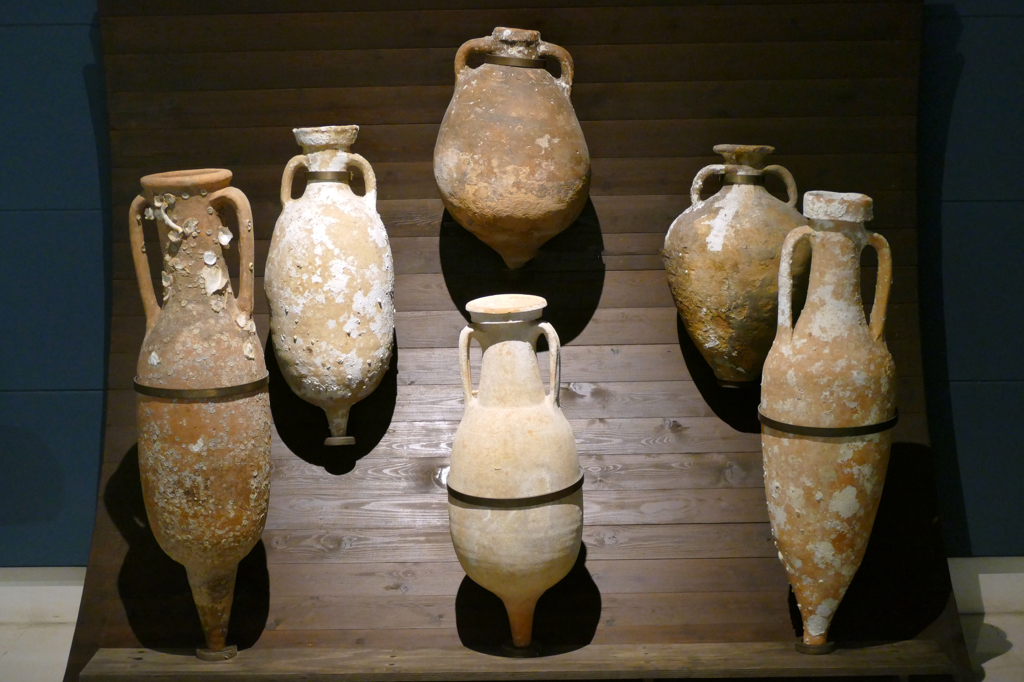
However, with the fall of the Roman Empire, Cádiz also lost its importance. The Visigoths conquered the Roman province of Baetica at the end of the 5th century. In 711, the governor of the caliph of Damascus in Tangier, Tāriq ibn Ziyād, initiated the Moorish invasion of the Iberian Peninsula and the Islamic conquest of the Visigoth Empire. The new masters rebuilt the city.
In 1262, the Castilian King Alfonso X conquered Cádiz and expelled the Moors, and settled Christians from the northern parts of his empire in the city.
New Prosperity
With the discovery of the Americas, Cádiz became important and prosperous as a port for the Spanish silver fleet. From a small place in the Gulf of Cadiz by the name of Puerto de Santa María, Columbus sailed to the New World on his second voyage in 1493. You should pass Puerto Santa María when going to Jerez and Seville.
In the 18th century, trade with the Spanish colonies was shifted from Seville to Cádiz because of the city’s easy access to the sea.

Obviously, Spain’s loss of the colonies was a severe blow to Cádiz’s trade. After 1900, the outdated port facilities were modernized. With the outbreak of the Spanish Civil War, Cádiz fell into the hands of the nationalists almost immediately. For them, it was the most important port for the transfer of General Franco’s soldiers to North Africa.
Today, the city’s picturesque old town stands in stark contrast to the modern buildings of the new town.
Cádiz is a very popular destination among local summer vacationers. Families from Madrid and Barcelona, but also many international visitors, spend the summer months on Cádiz’s beaches and the old town’s shady, narrow alleys.
Grand Tour of Cádiz
“If you need something, just give us a call”, offers Jose as he hands me the keys. I look around the lovely furnished apartment Rosario Uno*, equipped with well-functioning appliances, and cannot imagine needing anything else to make me feel more comfortable and at home away from home.
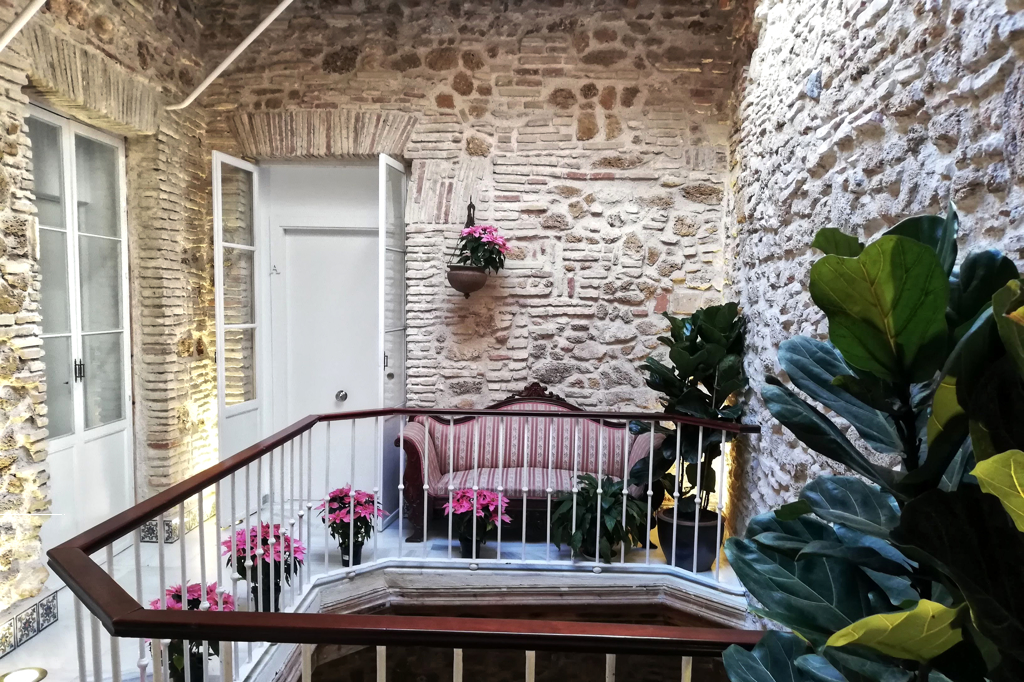
For tomorrow, I need something for breakfast, hence, I hit the local market. Although I hold myself back from buying all those beautiful and most certainly delicious shellfish and produce, I shop far too much for just two days. But everything looks so juicy and tempting. Can produce be sensual?

At the corner café across from the market, I order the smallest portion of churros. Nevertheless, I can hardly eat half of the huge ración of deep-fried dough dipped in liquid chocolate. So far, this city is a Cockaigne.
Back at the flat, I make myself a coffee and do a little laundry that I hang to dry in one of those typical Spanish half balcony, half window thingies. But despite the feeling of being a local Andalusian señorita, I’m not – and since I have only two days in this wonderful city, I make it down the two flights of stairs and find myself on a narrow cobblestone street in the heart of Cádiz.
Let’s Go
As I pointed out, despite Cádiz’s historic importance, the city is not very big and can be easily explored just by walking. When I call this chapter a grand tour, it’s not just a title. I actually took a tour around the peninsula at least once a day and then continued my walk on the promenade alongside the Atlantic Ocean. Watching the waves rolling in, listening to the screeching seagulls, feeling the soft breeze of early December on my face was just so soothing. Cádiz turned out to be a vacation within a vacation.
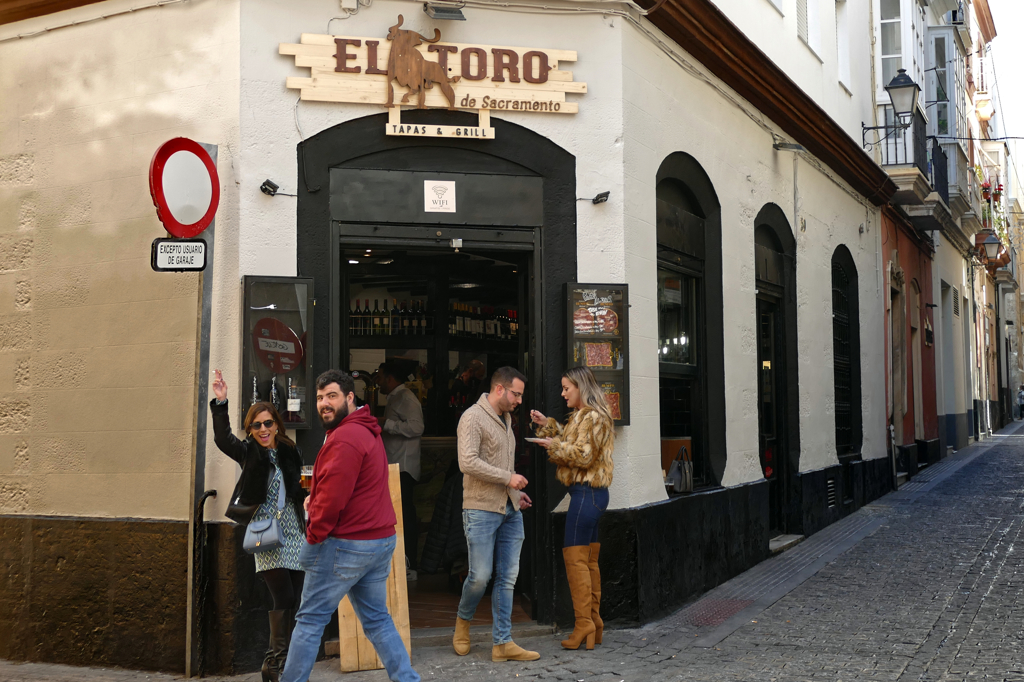
We start our stroll at the bus station across the harbor. From there, we walk westwards around the tip of the peninsula in a circle. So, put on some comfy shoes, and let’s go.
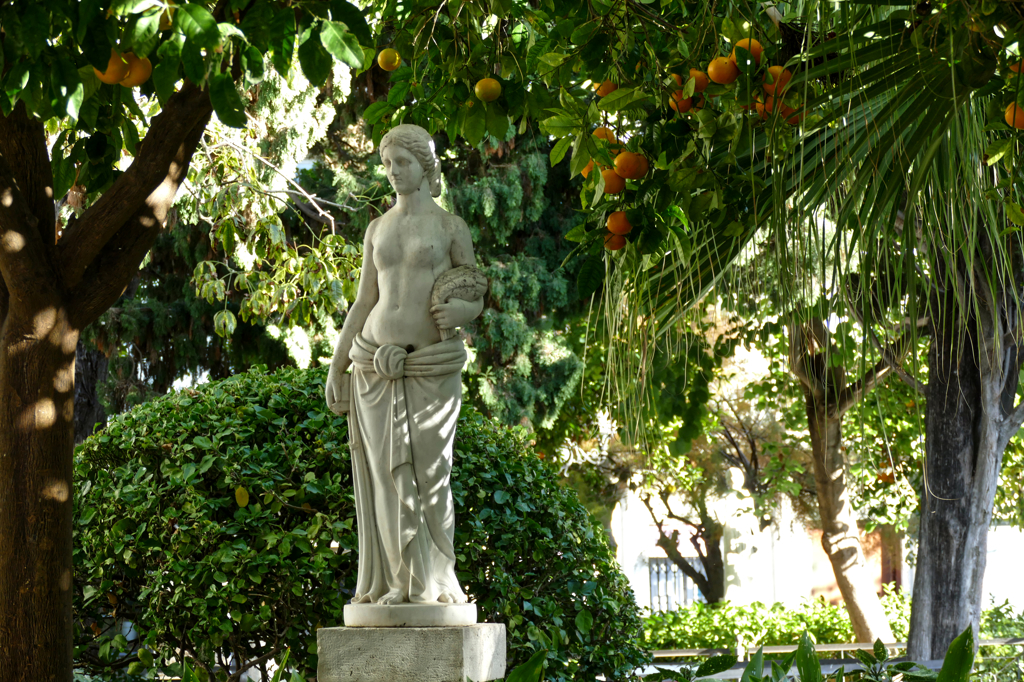
You definitely should explore Cádiz on foot. This way, you get a feel for the city and can enjoy all those amazing views at literally every corner.
Muralla Puertas de Tierra
The Puerta de Tierra was the entrance gate in the old city wall. Therefore, more than 500 years later, this majestic portico will grant us access to Cádiz, too.
The city wall’s first part was built in the 16th century, and eventually, many bastions were added. The Puerta de Tierra is a marble doorway designed by José Barnola that was built by Torcuato Cayón in 1756. As a matter of fact, it looks rather like a humongous altarpiece than like a fortification.
It definitely is one of the most significant monuments of the city and separates the historic old town from the new part of the city.
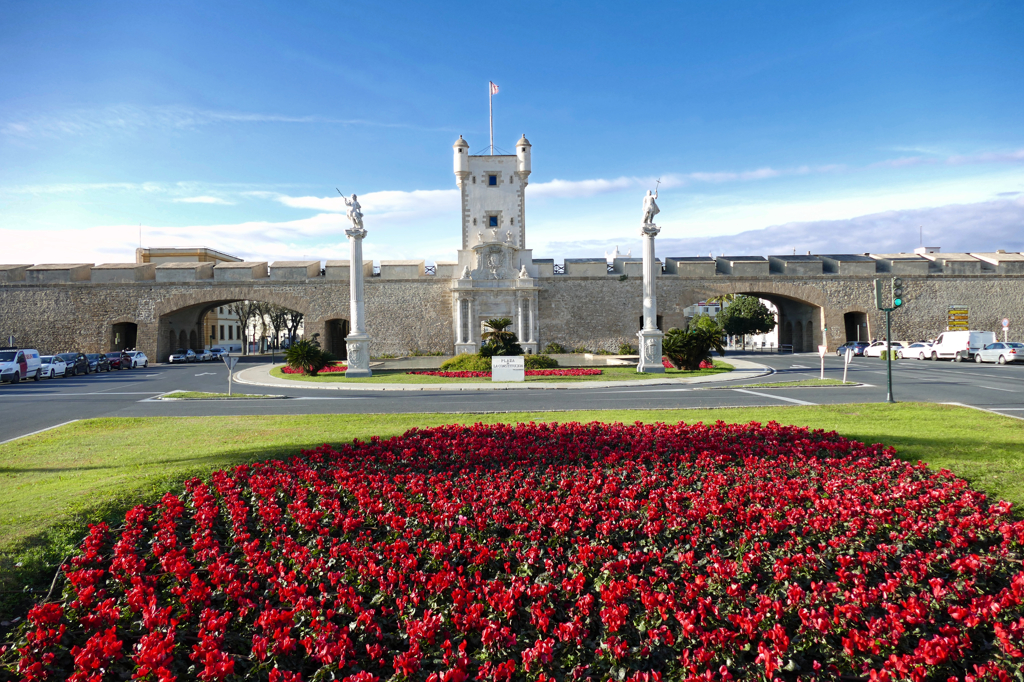
East of the wall is the stately Plaza de la Constitución. There, two victory columns are flanking the gate. On their tops are Cádiz’s patron saints San Germán and San Servando.
The tower above the gate was built for the purpose of optical telegraphy in 1850. This way, messages were sent from Madrid to Cádiz in two hours. At that time, definitely a big deal
Today, the tower and the promenade on top of the wall can be walked upon. The complex houses a Lithographic Workshop Museum and the Museo Del Títere, an Ibero-American puppet museum. Good to know in the unlikely event that it rains when you are visiting the city.
Baluarte de San Roque and Baluarte del Matadero
I mentioned the bastions above. Obviously, Cádiz’s wealth gained from trade with the overseas colonies brought the city not only friends, but also envious foes. It soon became the target of pirates who went on forays several times in the 16th century.
The city was also the target of attacks from the English. They defeated the Spanish Armada under Francis Drake in April 1587 and looted and burned the city in 1596.
During the Anglo-Spanish War of 1625, the English failed in their attempt to conquer the city. However, Admiral Robert Blake occupied Cádiz between 1655 and 1657.
No wonder that numerous ramparts, walls, fortresses, and other defensive facilities were built from the 17th century. They protected Cádiz from enemies from both the sea as well as the mainland.
Nowadays, some of Cádiz’s bastions are just silent reminders of glorious yet difficult times. Baluarte de San Roque and Baluarte del Matadero, however, are still in use. But today, they are not deterring people. On the contrary: Since they are housing galleries, workshops, as well as restaurants and bars, they happily welcome patrons and visitors.
Playa Santa María del Mar and Playa de la Victoria
What makes Cádiz so very attractive for basically every visitor is the unique combination of a historic city full of great architecture and culture, and some of the country’s best beaches. Even the relatively small city beach that I’m describing further below is not some filthy dump as city beaches tend to be, but actually quite idyllic.
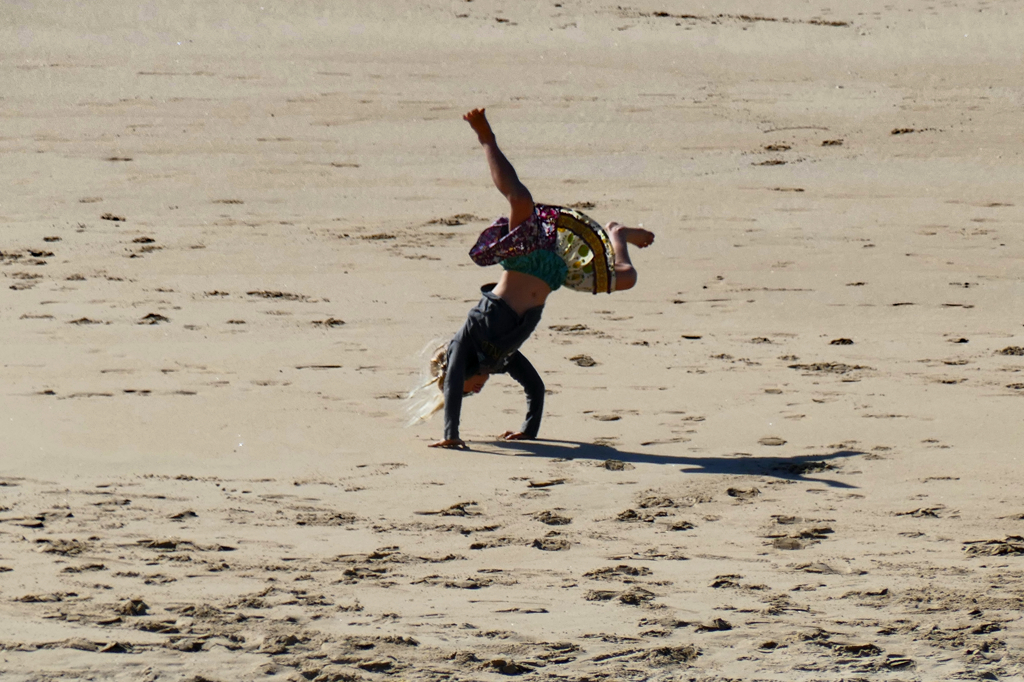
Nevertheless, as you walk further south from the historic center, the beaches get wider, wilder, and better.
The first one, right on the outskirts of the old town, is Playa Santa María del Mar. A promenade runs the entire length of the beach. Hence, you can choose whether to walk right on the fine golden sand or stroll down the boardwalk.

Golden yellow fine sand, clear turquoise water, and rough waves make this stretch a perfect playground for sunbathers and water sportsmen and sportswomen alike.
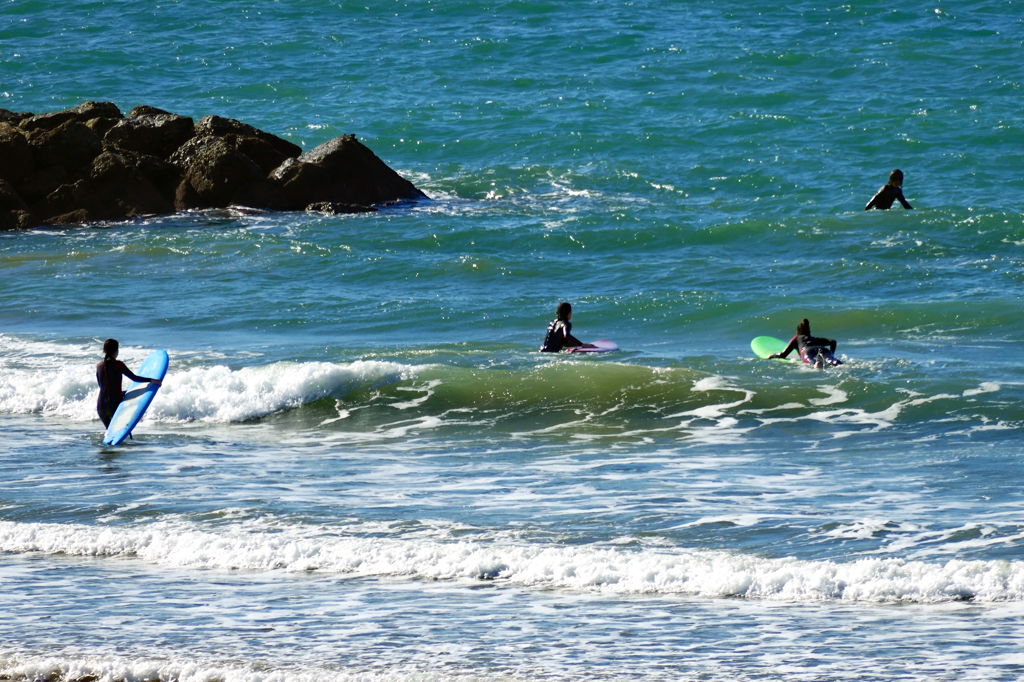
There are facilities like public bathrooms, showers, and trash bins for the visitors’ comfort. During the summer months, you can rent sunbeds and sunshades. There are signal flags informing of the safety and, obviously, lifeguards on duty.

Across the street from the promenade are cafés and restaurants in case you need a break from…doing nothing.
My Tip:
If you are into urban art, spare a couple of minutes for the Callejón del Blanco, a charmless residential street one block from the Playa de la Victoria. There is a long wall protecting a communal soccer field on which you get to see Cadiz’s best street art. I’m marking the street on the map below.
Flamenco
Now, let’s walk back from the beach towards the historic center. Right around the corner from the Baluarte del Matadero is the Peña Cultural Folklorica y Recreativa la Perla de Cádiz. A long name for an arts center promoting mainly local flamenco. The Peña Flamenca is conserving the art of flamenco dance by teaching and promoting it with shows and other related events.
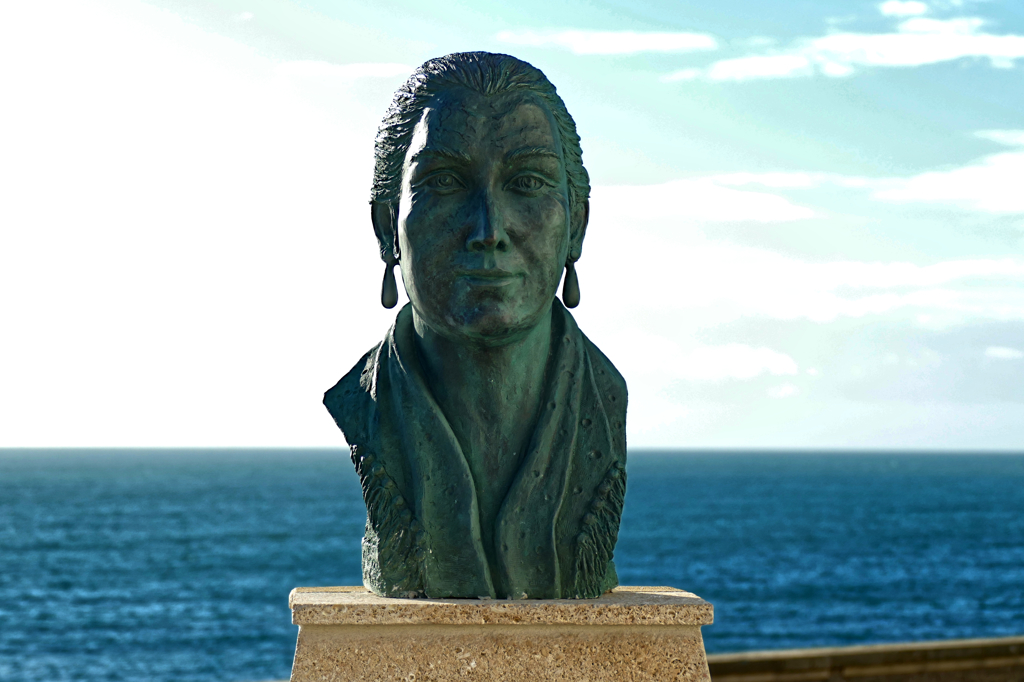
The pearl of Cádiz – the art center goes by the name La Perla de Cádiz, honoring señora Antonia Gilabert Vargas. The stage name of this flamenco singer of gypsy ethnicity was La Perla de Cádiz.
Already, her parents were flamenco artists. Born in 1924, Antonia won the First Prize for Bulerías at the Jerez National Singing Competition in 1962. She sang in Madrid, Seville, and in her hometown town Cádiz, obviously. There she died at the age of 51 in 1975.
Barrio Santa María
Santa María is the neighborhood right behind the Puerta de Tierra in the historic center. It is one of the oldest neighborhoods in the already quite old city, hence, it’s pretty old. Actually, it emerged in the 15th century.

Obviously, the Barrio Santa María has a rich history – also when it comes to the national cultural treasure that is flamenco. The main venue is the Centro de Arte Flamenco at the Plaza de la Merced. This institution dedicates itself to teaching, promoting, and performing the art of flamenco. Check out the program and schedule on their website.
Casa de Iberoamérica and Paseo Del Vendaval
Walking down the promenade Paseo Del Vendaval, from the Peña Cultural and the Baluartes north towards the historic center, you’ll pass a prominent Neoclassical building.
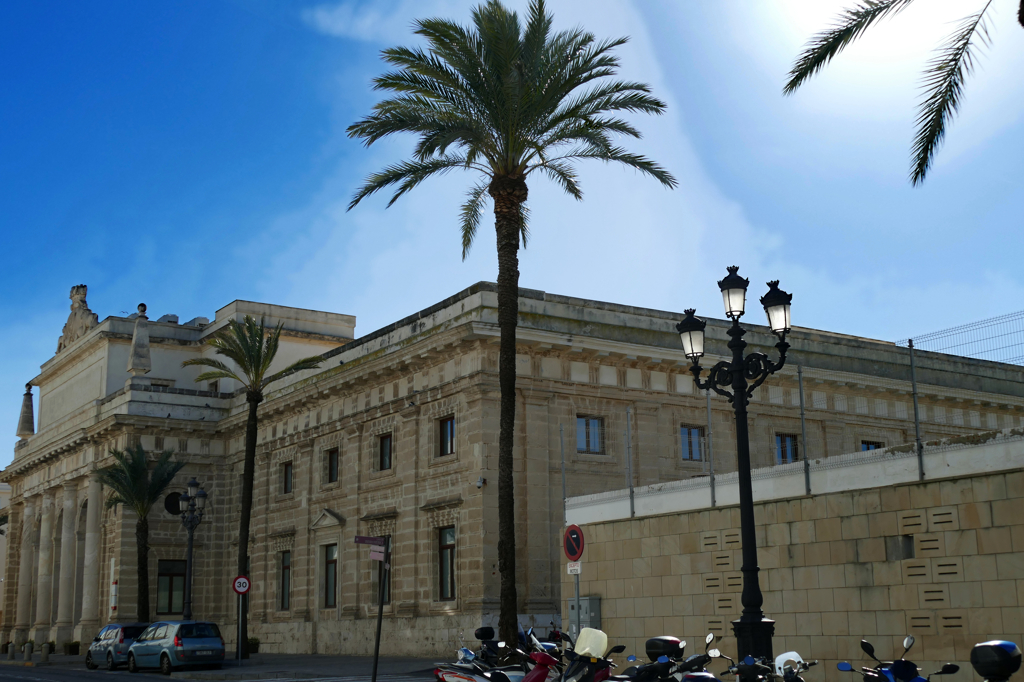
The reputable architect Torcuato Benjumeda designed it in 1794. Surprisingly, the last section, which is closest to the sea, was finished only in 1990.
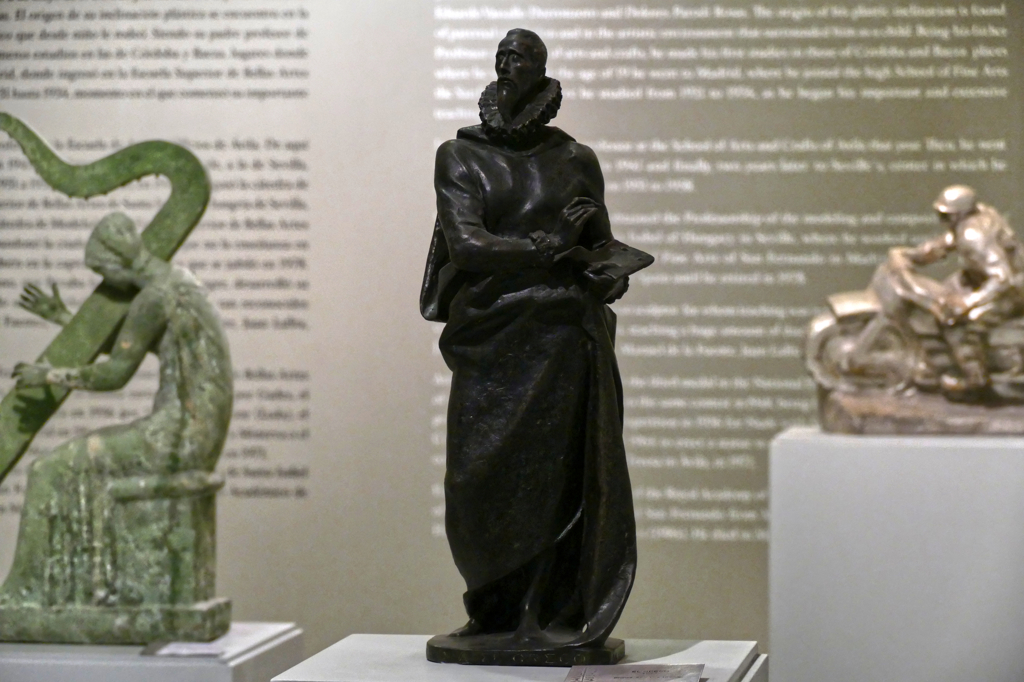
The building is, without a doubt, a masterpiece of Neoclassicism. Hence, it might surprise you that from 1836, it was a prison until 1966. Eventually abandoned for many years, it now houses the cultural center Casa de Iberoamérica.
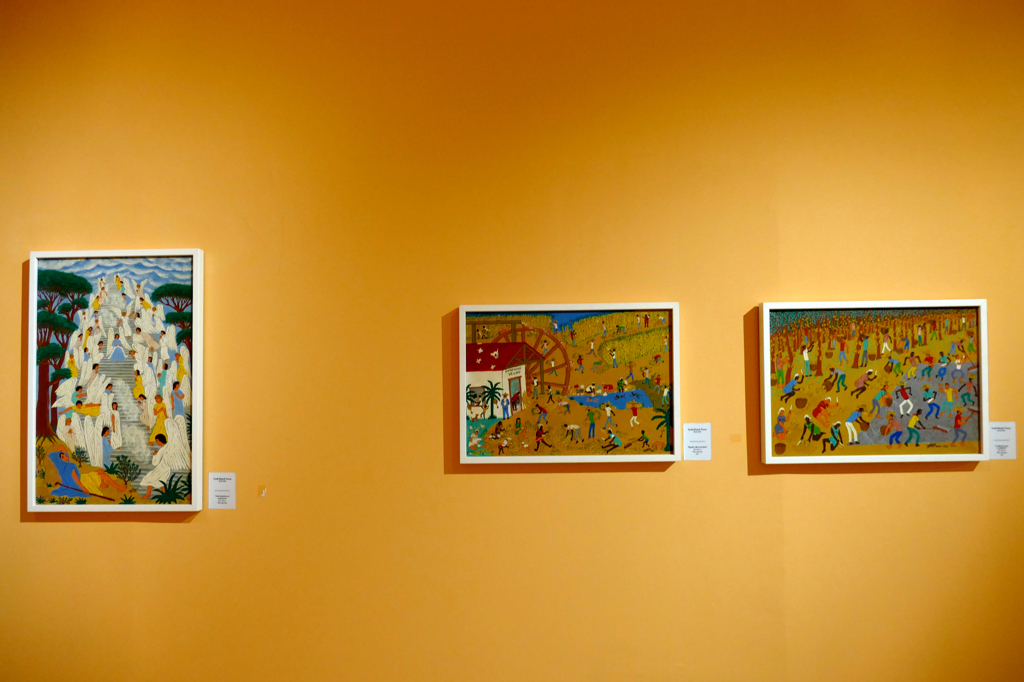
The Casa de Iberoamérica hosts events and organizes exhibitions of all kinds, mainly related to Latin America, obviously.
The gallery is open from Tuesday to Sunday from 10 a.m. to 2 p.m. and in the evening from 6 p.m. to 9 p.m. The visit is free of charge.
Teatro Romano de Cádiz and Arco de los Blanco
Cadiz’s Roman theater was built in the 1st century BC. It was the second-oldest in the entire Roman Empire and also the second-largest in Roman Hispania. With a diameter of 120 meters, it accommodated 10,000 visitors – at a time when the city had a population of 50,000.
From the 4th century, the theater was no longer in use. The Moors built a fortress over the ruins.
Interestingly, the remains of the Roman theater were only discovered during archaeological excavations in 1980.
The restoration work was a major challenge as there were various newer buildings standing on top of the former theater.
You can visit the site free of charge from April to September from Monday to Saturday between 11 a.m. and 5 p.m. and on Sundays from 10 a.m. to 2 p.m. Between October and March, visiting hours end at 4.30 p.m.

Just around the corner from the Roman theater is the Arco de los Blancos. It is a relic of an old Roman door. Over the centuries, different constructions were added to the original span and altered its original appearance.
The arch is made from yellowish Oyster stone, and you can even spot some shells in the bricks. In the past, the oyster stone was a popular construction material in Cádiz and can still be seen in many of the old structures of the historic center.
This former Puerta de Tierra opened to the medieval quarter and gave access to the royal butcher shops. Obviously, no one knew that under those shops were the ruins of a Roman theater.
Today, only the rear part of the Arco is conserved. The façade was dismantled to broaden the street in the 16th century.
A Quick Word About Oyster Stone
The so-called oyster stone is the local name of a sedimentary rock. It’s formed by remnants of seashells and rocks eroded by the seawater. This very porous material is widely used not only in Cádiz, but also in other towns along the Costa de la Luz, like Puerto Real and El Puerto de Santa María.
Buildings made from oyster stone can be easily identified by their yellowish to brownish color. The bricks are very porous and rough and often contain small shells and even mother-of-pearl.
Parroquia de Santa Cruz and Casa de la Contaduría and Museo Catedralicio
The Old Cathedral of Cádiz, or Church of Santa Cruz, dates from the early 13th century. King Alfonso X El Sabio commissioned the construction on top of the remains of an Arab mosque.
In 1597, Ginés Martín de Aranda was commissioned to reconstruct it in Mannerist and Baroque styles. Santa Cruz was a cathedral until the city got its new cathedral in 1883. Since then, Santa Cruz has been just a parish church.
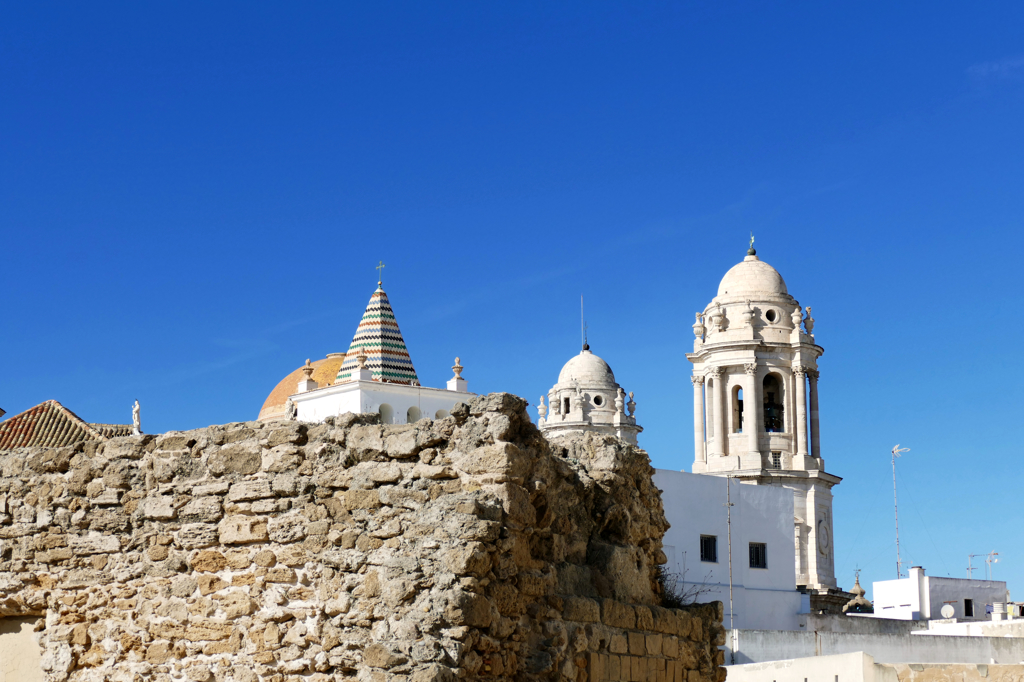
The Casa de la Contaduría is a complex of several elements grouped around the tower of the old cathedral. Those were first inhabited by chaplains and choirboys. Later, they became the College of Acolytes and Sixes.
The Casa de la Contaduría is open for tourist visits from Monday to Saturday between 10 a.m. and 7 p.m., Sundays from 1 p.m. to 7 p.m. Together with the Museo Catedralicio, it is included in the tourist ticket for the Catedral de Cádiz.
Catedral de Cádiz and Iglesia de Santiago Apóstol
The baroque and neoclassical Cathedral of Cádiz is the episcopal seat of the city’s diocese. Construction began in 1722 and was not finished until 1838. The loss of power in the Americas and the related economic crises caused the construction in steps and consequently in varied designs.
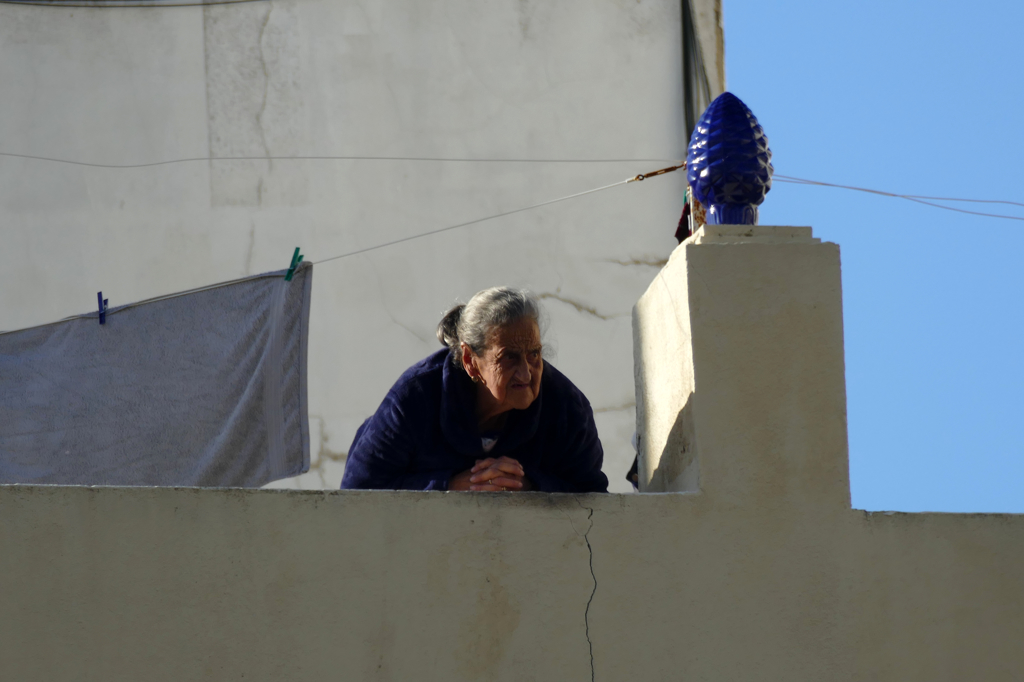
Its location in the historic center of Cádiz is almost by the sea. You can spot this majestic building from almost every spot in the city.
The entrance to the cathedral also leads to the Cathedral Museum of Cádiz.

There you can admire the Cathedral’s religious artifacts, paintings, and sculptures. Among the treasures is the just incredible Custodia del Millón, a four-meter-tall silver monstrance set with precious gems from the 17th Century.
Apart from the main house of worship and the museum, a complete visit to the cathedral also includes the clock tower. The general ticket costs 6 €uros. Touristy visits are possible on Mondays from 10 a.m. to 3 p.m. and from Tuesday to Saturday till 4 p.m.
Iglesia de Santiago Apóstol
The Church of Santiago dates from 1635 and is standing on the northwest corner of the Plaza de la Cathedral. It was the seat of a school of the Society of Jesus, yet today, only the house of worship remains.
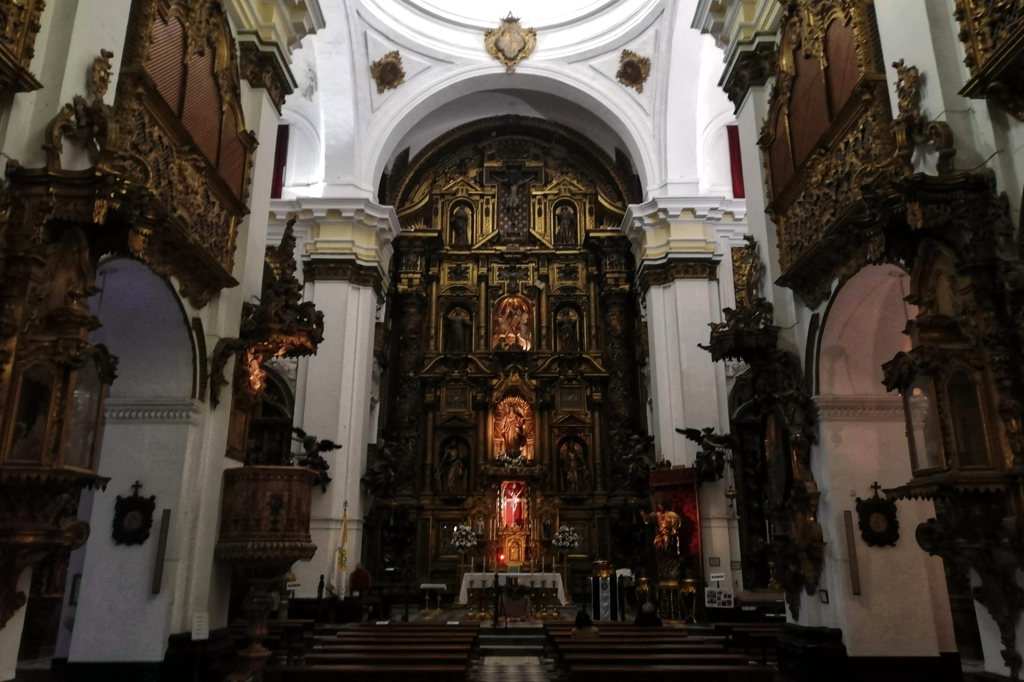
The church was built in the Mannerist style, adopting the appearance of Vignola’s Chiesa del Gesú in Rome. The main façade faces the Plaza de la Catedral. It consists of 14 paired Ionic pillars made from oyster stone.
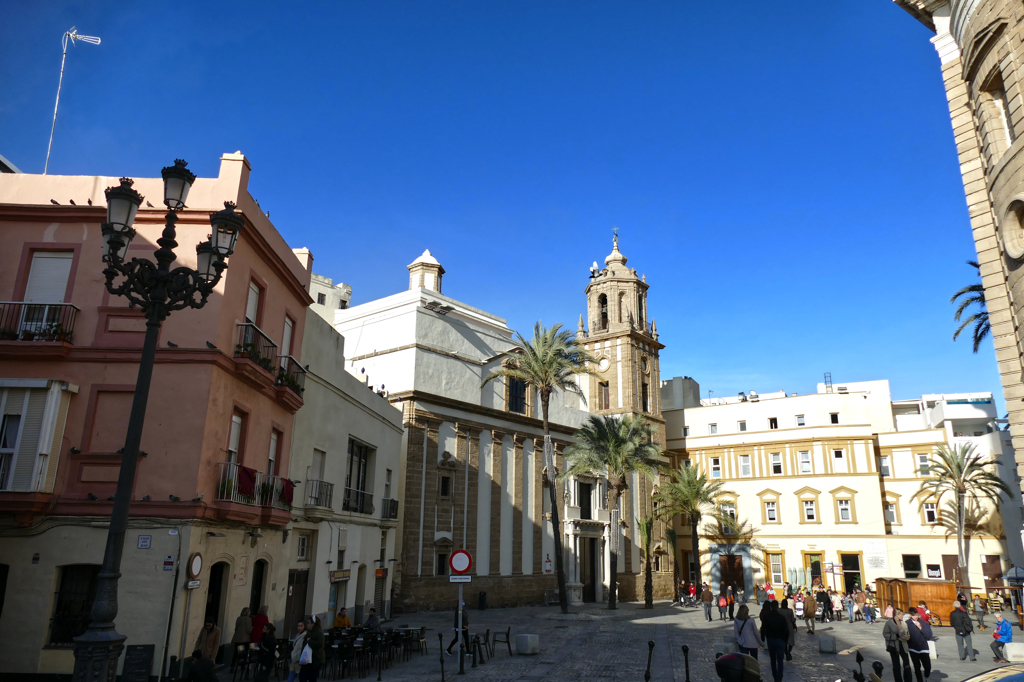
Inside are some interesting baroque altarpieces from the 17th century. The most impressive one is certainly the main altarpiece. This altarpiece has three storeys. On the low level is a carved sculpture of the Virgin Mary Immaculate. Above the Virgin is a carving of the titular saint Santiago. On the upper level is a carved Crucifix.
When visiting the church, keep in mind that there is a service every day at 9.30 a.m. and a vesper at 8 p.m. At these hours, you should refrain from touristy visits.
La Casa del Almirante
Don Diego de Barrios commissioned his so-called Admiral’s House in 1685. He was the Admiral of the fleet, Flota de Indias, after all.

It is one of the most prominent examples of how luxuriously shipowners lived during Cadiz’s gilded age. The red marble from Genoa covers the imposing baroque façade. Four paired Tuscan columns flank the entrance door and give it an extra-swanky appearance. Two viewing towers with pilasters finish the building off.
Behind the façade facing the Plaza San Martín, a colonnaded patio, a stately staircase under an elliptical cupola, and a grand entrance hall underline the building’s exquisiteness.
Castillo de San Sebastián and Faro de Cádiz
Back to the western shore, visiting the Castillo San Sebastián is just spectacular. The fortress on a small rock island is washed all around by the rough Atlantic Ocean. You have to cross the sea on a long promenade.
Construction began in 1706. At first, access to the fortress was possible only over a suspension bridge, then, in 1860, today’s boardwalk was built.
The lighthouse was built on the foundation walls of a Moorish watchtower in 1908.
It is 41 meters high and was Spain’s second electrical lighthouse.
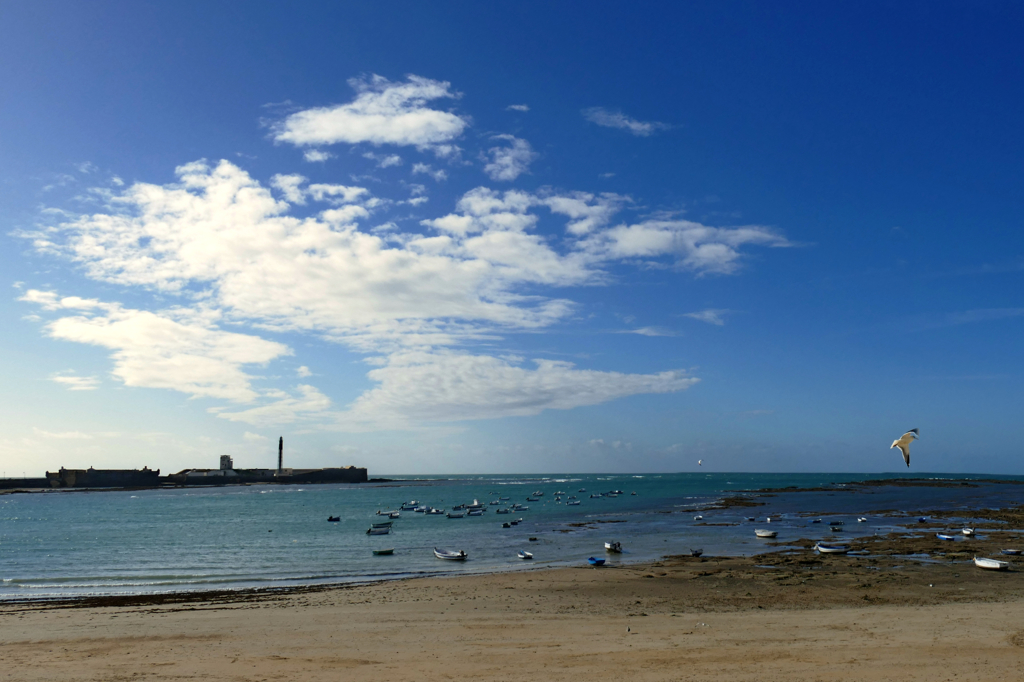
The silhouette of the fortress in the Atlantic Ocean was the dramatic setting in several movies. For instance, parts of the James Bond movie Die Another Day were shot at this unique fortress.
While you can stroll down the causeway, you cannot really access the Castillo de San Sebastián. However, views of the city and the wide sea are fantastic – especially at sunset.
La Caleta and Castillo de Santa Catalina
La Caleta is a small beach between the Castillo de San Sebastián and the Castillo de Santa Catalina. Since it is located right on the western shore of the old town, it is the most popular beach in all of Cádiz. As a matter of fact, La Caleta is very well-maintained, unlike some dirty dump city beaches tend to be.
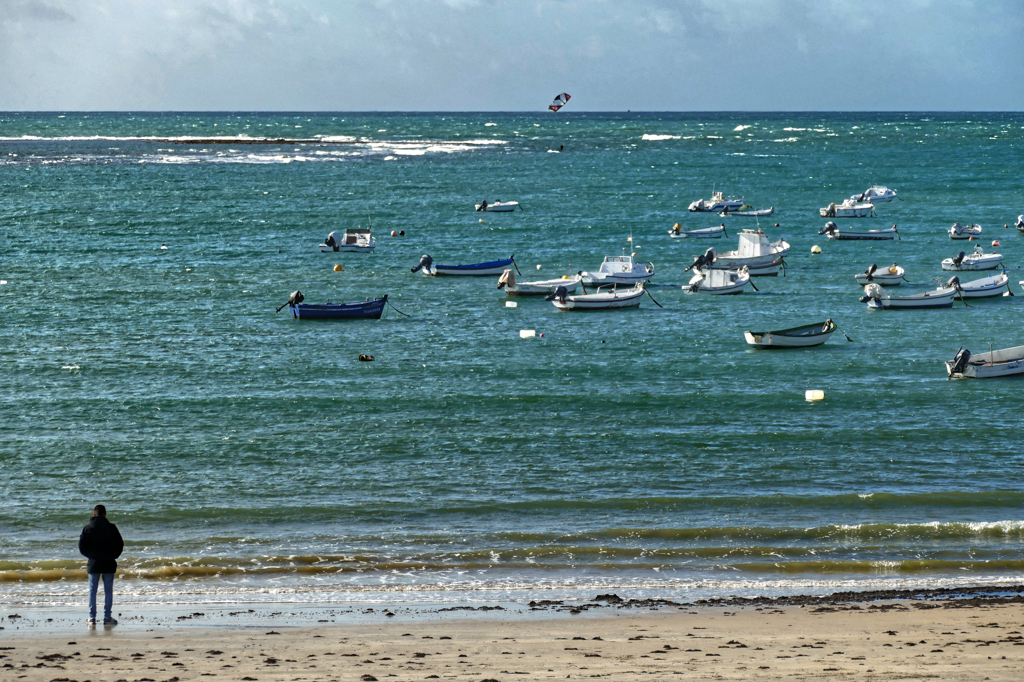
Around the beach are restaurants and bars, as well as the former spa house Nuestra Señora de la Palma y del Real.
During wintertime, La Caleta is a perfect spot for a beach walk or a drink at one of the bars. In summer, you might want to spend the entire day on the fine golden beach and take a refreshing dip in the waves of the Atlantic Ocean under the surveillance of lifeguards on duty.
Castillo de Santa Catalina
After the British sacked Cádiz in 1596, Felipe II ordered the construction of a defensive fortress for better defense. About a hundred years later, Carlos II commissioned a chapel in honor of Santa Catalina of Alexandria and a sacristy inside the fortress. Carlos III used the fortress as a military prison for liberals and American fighters for independence from 1769. For instance, Mariano Abasolo, a leader of the Mexican independence movement, spent five years in this prison before he died there of pulmonary tuberculosis. The Ministry of Defense ceased to use the fortress only in 1991.
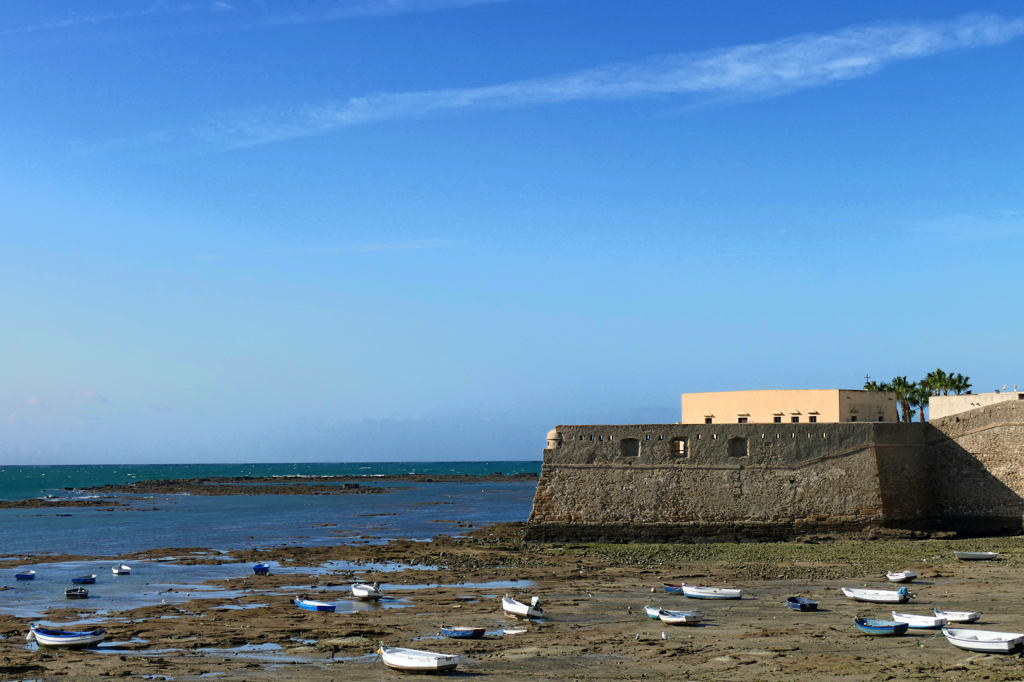
Today, the Castillo de Santa Catalina houses a cultural center with a permanent historical exhibition of the region as well as temporary art and craft presentations.
Parque Genovés and Fuente de los Niños del Paraguas
Due to a cholera epidemic, the local administration became aware of the need for greenery so that the population had spaces to relax and recover.
After the demolition of the fortress Cuartel de la Columela in 1863, they were able to enlarge a former green stretch into a park with many species of trees. However, in 1892, the park underwent its most extensive redesign. Architect Gerónimo Genovés i Puig came from Valencia to expand the park. Not only did he plant rare and unique plants. He also commissioned fountains, a lake with a small waterfall, concert halls, and a café.
None other than Gustave Eiffel built a theater in the park at the end of the 19th century. Therefore, to this date, not only is the Parque Genovés Cadiz’s lush botanical garden. In summer, many theater and concert performances take place on the open-air stage.
Fuente de los Niños del Paraguas
One of the most striking sculptures at the Parque Genovés is the fountain of Pablo and Virginia. Those two are the protagonists of the novel Paul et Virginie by Jácques-Henri Bernardin de Saint-Pierre. In this novel, first published in 1788, Paul and Virginie are friends since birth and later fall in love. The story is set on the island of Mauritius and written on the eve of the French Revolution and the liberation of the French colonies.
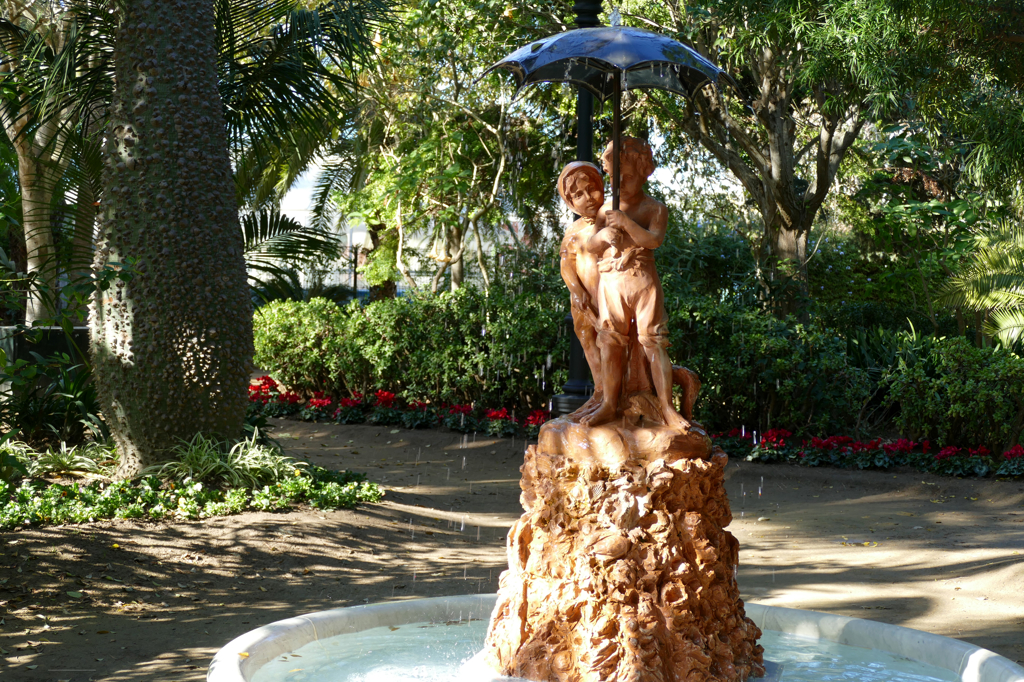
The fountain at the Parque Genovés is 160 cm high and was made at the workshop of Andrea Boni e Compagna in Milan. Paul is holding a metal umbrella whose central bar ejects a jet of water. It thus spreads over the entire outer surface of the umbrella and falls around the couple. This way, it perfectly achieves the illusion of falling rain.
ECCO – Espacio de Cultura Contemporánea de Cádiz
Obviously, there is a lot of amazing historical stuff to admire in the oldest city in Europe. However, Cádiz also has a very modern and dynamic vibe. There are long beaches attracting the young, sporty crowd. Then, there is also a university. And there are also modern facilities, for instance, the ECCO.
The modern venue is the result of the transformation of an old military base in the Barrio de Carlos III. The remodeled facilities are housing an atrium, a courtyard, and a generous gallery.
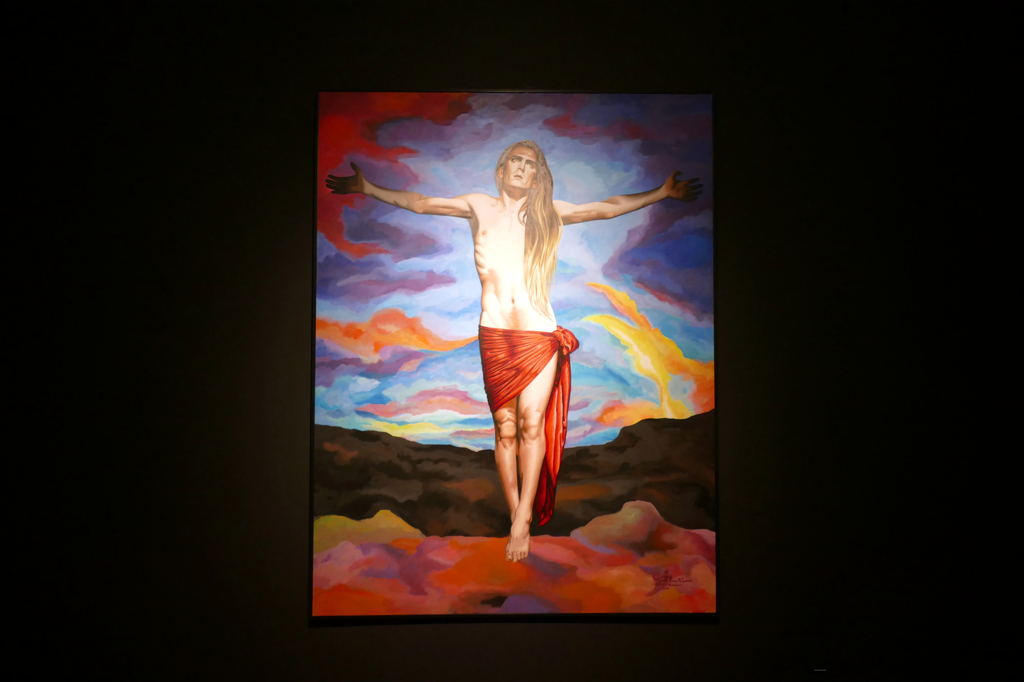
No matter on which occasion you are visiting the ECCO, you’ll always be able to see the permanent exhibition El Valle de los Caídos. Enrique Naya Igueravide and Juan José Carrero Galofré, better known by their pseudonym Costus, created a series of paintings inspired by the sculptures decorating the Basilica of the Valley of the Fallen in Madrid. Their work rather moved than amazed me since their style has clearly deep roots in the 1980s, hence, flashing the colors and aesthetics of punk and new romantic.
You can visit the ECCO free of charge from Monday to Saturday between 11:00 a.m. and 9:00 p.m. and on Sundays and holidays from 11 a.m. to 3 p.m.
Jardines de Alameda Apodaca
The Alameda Apodaca y del Marqués de Comillas is a landscaped walkway and probably my favorite spot in Cádiz since it’s not only lush’n’shady but also full of intriguing sculptures. It runs parallel to the sea from the walls of San Carlos and ends at the Baluarte de la Candelaria.
A walk consisting of three streets and divided by rows of trees was built in the 18th century. Between 1926 and 1927, the architect Juan Talavera y Heredia carried out a transformation of the avenue, turning it into a Sevillian-style garden. This makes total sense since he had already designed the Murillo Gardens in Seville.

The park consists of a series of circular and rectangular gazebos. In the center stands a monument to the Marqués de Comillas. It basically divides the space into two parts. For the benches, fountains, and lampposts, Talavera used glazed ceramics and wrought iron.

A Gentle Giant
There are flowerbeds and bushes. However, the most impressive feature is the trees. The most impressive one is a humongous ficus, planted at the beginning of the 20th century. When you see its size, you won’t believe that it took the tree only about 100 years to grow to these dimensions.

Interesting are the busts of the leaders of many Latin American countries. However, the most striking piece of art is the statue of Carlos Edmundo de Ory. This avant-garde poet and founder of the honorable Academia Hispanoamericana de Cádiz, the city’s Spanish American Society, was born in Cádiz. Later, he lived with his wife, French artist Laura Lachéroy, in the village of Thézy-Glimont in France. That’s where he then died in 2010.
Cadiz Museum and Plaza de Mina
The building that houses today’s Museum of Cádiz was initially part of a Franciscan convent. The Plaza de Mina was originally the cloister’s kitchen garden.
Architect Juan Daura Jover redesigned the building in 1838. In 1852, some of the galleries were given to the Academia de Bellas Artes, the city’s Academy of Fine Arts. Initially, mainly paintings and other objects from the secularized monasteries were on display. The impetus for the archaeological galleries was the finding of a human-like sarcophagus in 1887.
Both branches were united as the Museo de Cádiz in 1870. Since then, the archaeological collection is on the ground floor and the so-called fine arts are decorating the first floor. Some contemporary paintings are on the second floor.

Especially if you are interested in Cadiz’s exciting history, you shouldn’t miss out on the archaeological department. There you can admire, for instance, two Phoenician marble sarcophagi from the 5th century. Also, there are amazing amphoras and mosaics from the city’s Roman times.
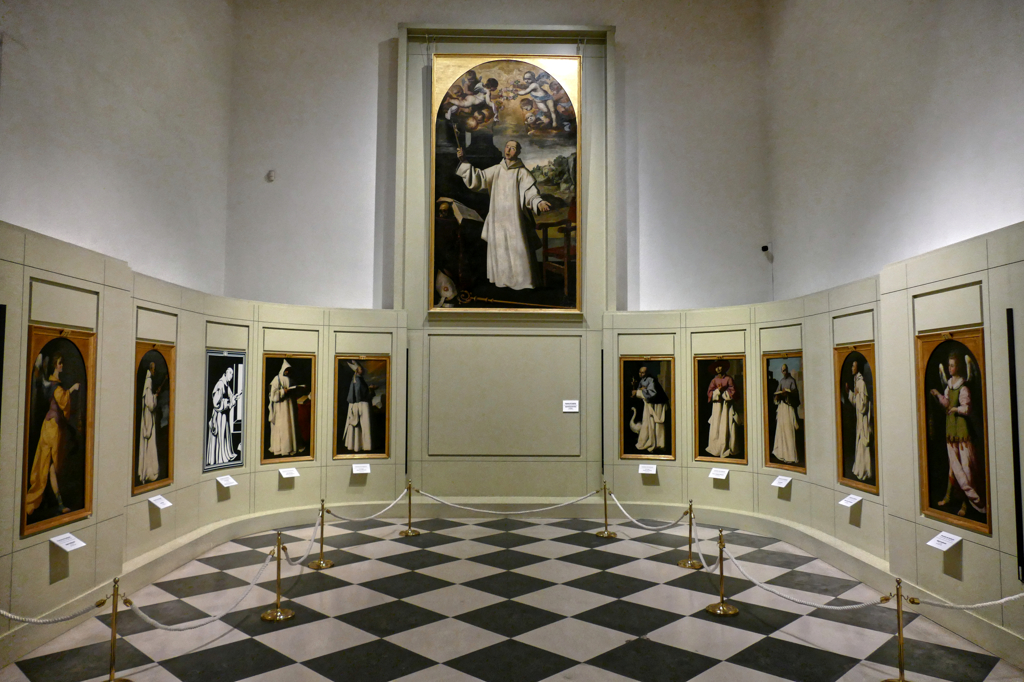
Nevertheless, I spent most of my visit upstairs at their wonderful Zurbarán display. This baroque painter is one of my favorites and the museum owns an amazing collection of his works.
Citizens of the European Union can visit the museum free of charge, all others pay as little as 1.50 €uros. Opening hours are from Tuesday to Saturday between 9 a.m. and 9 p.m.
Plaza de Mina
The museum is only one of the beautiful and majestic buildings that surround the Plaza de Mina. There is a great variety of architectural styles, however, most of them are baroque and neoclassical.
As I mentioned above, the Plaza de Mina was San Francisco’s orchard. In 1842 the entire area became a public square. Andalusian architect Torcuato José Benjumeda y Laguada started the project. He structured the square in a quadrangular shape with four diagonal streets that intersected in the center forming a roundabout.
As a matter of fact, the Plaza de Mina is not only one of the most beautiful parks in Cádiz. It is also an important address in the city’s history. At number 3 is a commemorative plaque informing that musician Manuel de Falla was born in this house in 1876. Number 12 is the house where geologist José Macpherson y Hemas was born. Ana de Viya – a wealthy yet charitable citizen of Cádiz – lived at number 8 in the 19th century. Admittedly, she’s not very well known outside the city limits. Finally, today’s numbers 17 and 18 housed the Hotel Francia y París, one of the city’s most exclusive establishments. Also, various political parties and associations have their offices in the buildings surrounding Plaza de Mina.
Convento de San Francisco and The Refuge
Well, not all of the convents of San Francisco became Cádiz’s city museum. Nevertheless, only the cloister and the church remain from the once stately property.
The convent was founded in 1566. During the 18th century, it underwent a major remodeling and got its current Baroque appearance. I played an important role in Spain’s colonial era. From here, friars were sent to the Americas, among them the famous Fray Junípero Serra y Ferrer.
As I explained above, the old convent of San Francisco was partly transformed into the current Museum of Cádiz. After the confiscation, the conventual dependencies were greatly reduced, and they are currently made up of the Mannerist rectangular cloister and the church.

Hidden in the northern corner of the Plaza de San Francisco is the so-called Refuge. This church, although housed in the Catholic San Francisco complex, is not linked to any religious denomination.
Even if you don’t care much about those houses of worship, you absolutely should pay the Plaza de San Francisco a visit. The square is basically lined with nice restaurants and cozy outdoor seating.
Plaza de España and Monumento a la Constitución de 1812
Nomen est omen, the Plaza de España is one of the most important squares in the Cádiz. Located near the port, the square is home to unique buildings such as the House of Four Towers, the old Customs Building, and the Monument to the Constitution of 1812.

The Monument to the Constitution of 1812 commemorates the centennial of the signing of the Constitution in the year – come one, take a wild guess. Aniceto Marinas García sculpted the monument after a design by Modesto López-Otero y Bravo in 1912. Yet, it was completed only in 1929.
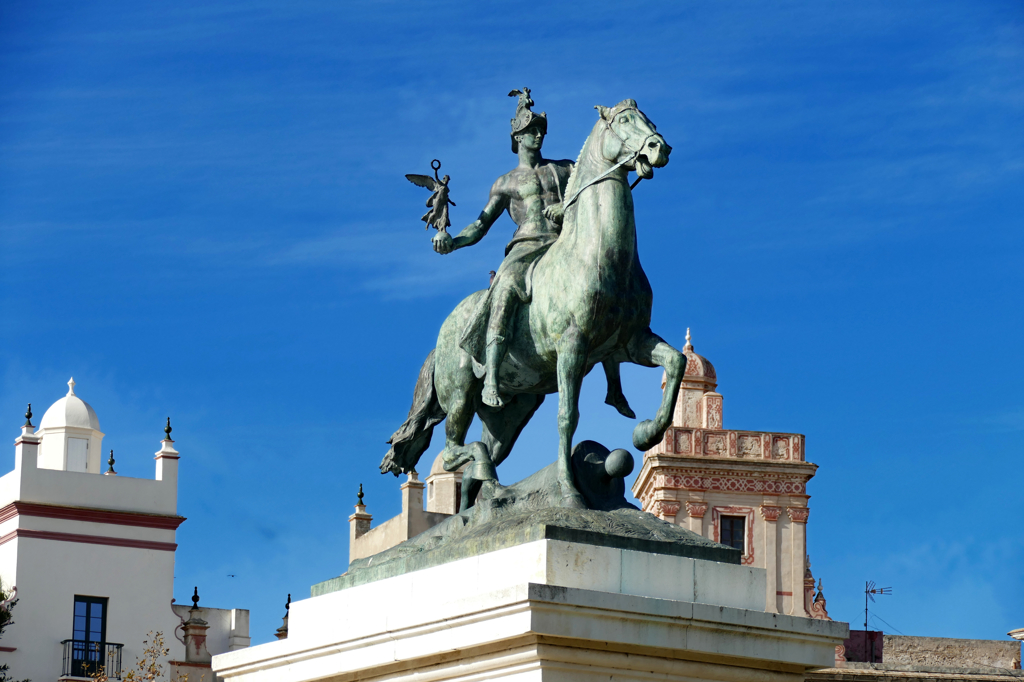
On each side of the monument are bronze figures representing peace and war. On the monument’s lower level is an empty presidential armchair. Above rises a column that allegorically symbolizes the principles of the constitution. At the pilaster’s foot is a female figure representing Spain. To either side are sculpted groups representing the peasant population and the bourgeoisie.
Torre Tavira
The Torre Tavira is one of Cadiz’s most visited tourist attractions. In the past, it was the city’s official watchtower. As a matter of fact, at 45 meters above sea level, it still is the historic city center’s highest spot. Don Antonio Tavira was the first guardian of the tower, and he gave the outlook his name. Tavira observed the horizon through his telescope and announce the arrival of ships for instance from the Americas.
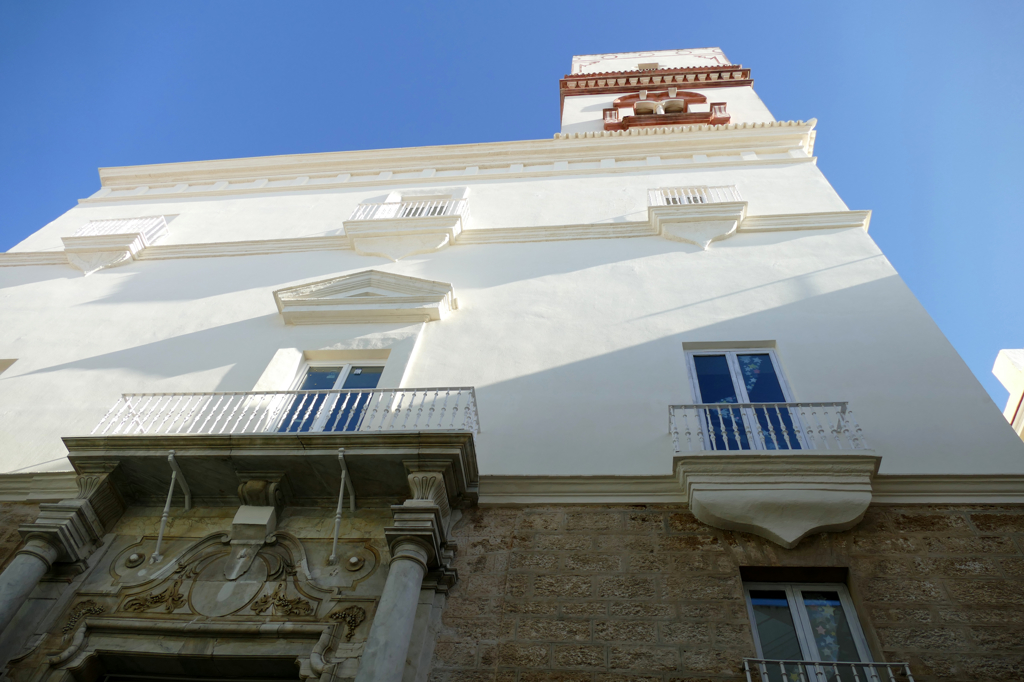
Today, the tower houses a camera obscura. It grants you the opportunity to see the whole of Cádiz on a screen from a whole different perspective.
In addition to the Camera Obscura, the Torre Tavira has two exhibition halls and a viewing terrace which allows a wonderful view of the whole city, hence, from the usual perspective.
Iglesia del Oratorio de San Felipe Neri
The baroque San Felipe Neri oratory was built between 1685 and 1719. An earthquake that actually had its epicenter more than 500 kilometers away in Lisbon damaged it severely in the year 1755. Pedro Afanador rebuilt the oratorio a couple of years later in 1764.
Actually, this was the place where the Constitution of 1812 was drawn up. Plaques commemorating this event cover the oratorio’s striking façade. Inside, the grandiose painting Immaculate Conception by Bartolomé Esteban Murillo adorns the main altarpiece. Supposedly, it is one of the master’s best works.
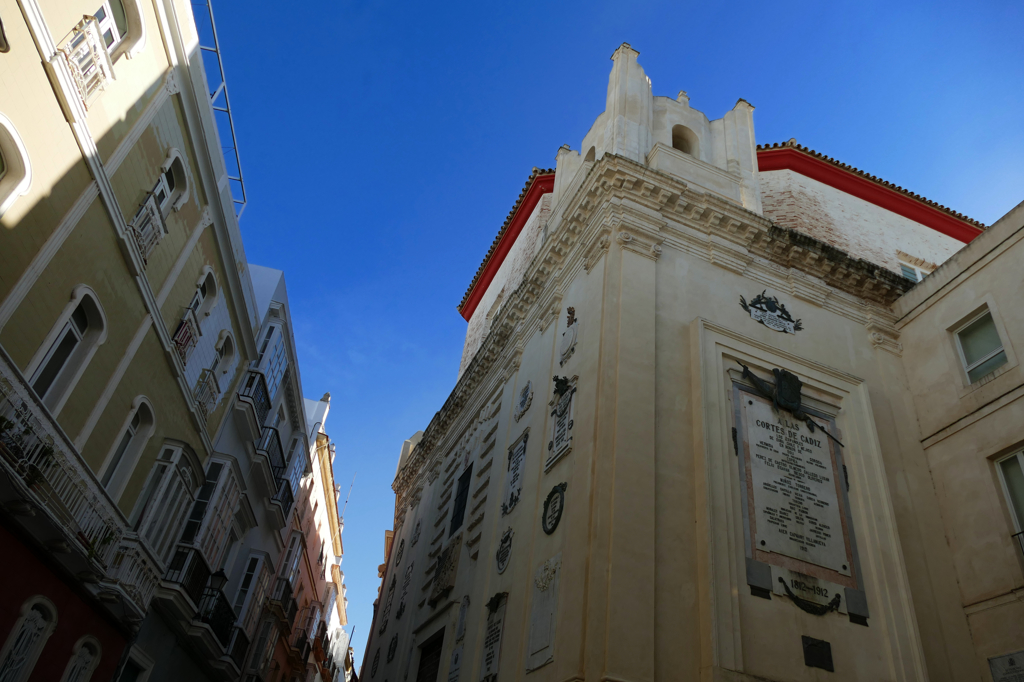
You can see it – and the rest of the interior – during the visiting hours from Tuesday to Friday between 10 a.m. and 2 p.m. and then again in the afternoon from 5 p.m. to 7.30 p.m. Saturdays, the church is open from 11.30 a.m. to 2 p.m. On Sundays, admission is free from 10 a.m. to 2 p.m., but note that there is a service in Latin at noon.
Casa de las Viudas and Gran Teatro Falla
The Casa de las Viudas, the Widows’ house, is located in the Plaza Fragela across from the Gran Teatro Falla. Juan Clat Fragela, a wealthy merchant of Armenian origin, commissioned the house. It granted widows and women without financial resources shelter.

The building dates from 1756. The two-storey building is designed in a baroque style around a courtyard. On the upper floor is a small oratory with a neoclassical altarpiece. The nave houses an impressive Byzantine panel from the 16th century as well as Baroque paintings from the 17th century. However, since this is still a shelter for people in need, you cannot just barge in to check it out, obviously.
Gran Teatro Falla
As you turn your back on the Casa de las Viudas, you see Gran Teatro Falla.
Following the design of Adolfo Morales de los Ríos y García de Pimentel, who was born in Seville and died in Rio de Janeiro, and Adolfo del Castillo Escribano, construction of the building began in 1884. Its predecessor, the wooden Gran Teatro de Cádiz, had caught fire in 1881.
Inaugurated with the interpretation of a symphony by Barbieri in 1910, it was renamed in 1926 from Gran Teatro to Gran Teatro Falla. This way, the city honored her favorite son, the composer Manuel de Falla.

The building, made from red brick in a flashy Neo-Mudejar style, has three large arch doors on its main façade. The auditorium can accommodate 1214 spectators. They get to see plays and concerts, but sometimes also musicals and operas.
Practical Information
How to Get There
There is no airport in Cádiz, the closest one is on the outskirts of Jerez de la Frontera. Alternatively, you can go to Seville. From both cities, you can continue to Cádiz by bus or train. The M-050 line connects the airport with both, Jerez de la Frontera and Cádiz, stopping at strategic points in either city. This service works every day of the week.
Especially if you get in on a late flight, the most comfortable option is taking a cab*, obviously.
I’m not driving, but if you do so, you’ll find seven car rental companies right at the airport in Jerez and five at the one in Seville.
Long-Distance Bus
Travelling by long-distance buses between cities in Andalusia is actually a comfortable option. The cheap prices make up for the little loss of time compared to trains. Also, sometimes there are more bus connections than trains.

Cádiz’s bus station is located just outside the city center, close to the wharf on Avenida Astilleros 302 behind the train station. There is a regular connection to Seville, Jerez de la Frontera, the beach town along the Costa de la Luz, and many Andalusian cities like Ronda and Malaga.
Train
Also, Cádiz’s train station is located in the vicinity of the harbor just south of the historic city center.
There are long-distance trains linking Cádiz with Madrid via Seville, Córdoba, or Ciudad Real.
The quite frequent medium-distance trains take you to Cádiz from Seville in 90 minutes and Jerez in 45 minutes. Tickets start at less than 17 respectively 7 €uros. You can buy them from vending machines or online.
Ship
Yap, it’s also possible to get to Cádiz by sailing. Cruise ships often dock within easy walking distance of the old town. This way, passengers can also take day trips to Seville in about two hours or Jerez De La Frontera in less than 1 hour by bus. There are frequent commuter ferries to Rota and El Puerto de Santa Maria.
Cadiz is also an important harbor when looking for travel to the Canary Islands. You can check ferry operators and schedules on this website.
How to Get Around
As in many historic old towns, driving is more of a challenge than a convenience. The old town can be easily walked, and it is not easy to ride a car along the extremely narrow alleys.
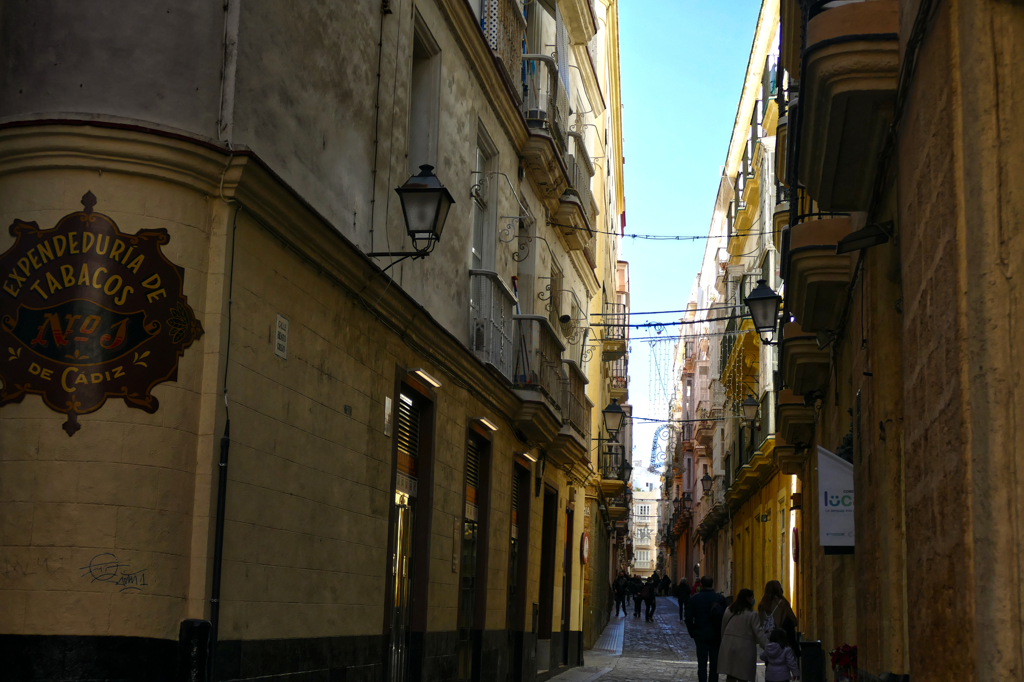
There are five bus lines in Cádiz. All of them are going in loops. For visitors, the most useful one is number 1. It goes from the Plaza de España in the old town to the southern end of the new town called Cortadura and passes the central bus station as well as the train station. Line number 7 follows the open sea coastline and links all the urban beaches. One ride sets you back as little as 1.10 Euros.
However, if you have more than a couple of minutes to spend in Cádiz, you shouldn’t bother to check out public transportation. Also, you definitely should refrain from driving.
To this date, I wonder how to explore the city on the hop-on hop-off bus tour they are offering. After all, the historic center stretches 1.8 kilometers from east to west and 1.2 kilometers on the north-south axis. Most of the streets within this radius are so narrow that you can almost touch both sides as you spread your arms. Where do you want to hop on or off?
Where to Stay
As Cádiz is not only a historically important seaport but also has fantastic beaches just minutes from the old town, there are various lodging options – from towering tourist hotels along the coast to charming guesthouses and B&Bs in the heart of the historic center.
I actually hit the jackpot with the apartment Rosario Uno*, located right in Cadiz’s center on Calle Rosario 1. It is nicely furnished and has a complete kitchenette including a coffeemaker, a microwave, and a washing machine. For up to two people, it’s the perfect accommodation, even for longer stays.

It’s literally just a few steps from shops, restaurants, and all landmarks and points of interest. Although you are in the middle of everything, it’s not noisy – as soon as you close the large windows, that is.
However, if the apartment is not available, you’ll find suitable lodging options in Cádiz on this map*:
What to Eat
In Cádiz, you will find some of the best and freshest fish and shellfish. To really enjoy their taste, you should order them cooked as simply as possible, hence, grilled, baked, or boiled.
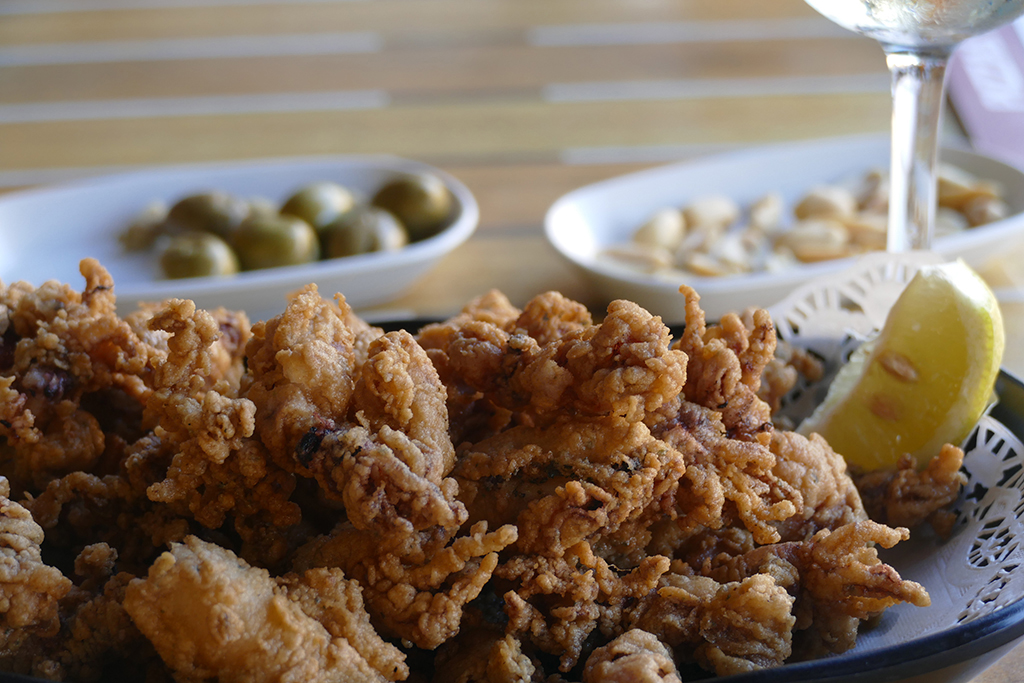
Very nice is the local squid. You should definitely eat it a la plancha, hence, grilled. But make sure to also try a big, stuffed one as well as deep-fried baby squid in a light batter.
Bakeries and Delis
There are many small bakeries and delis selling all kinds of sandwiches and empanadas. If you have a sweet tooth, you’ll also find a great variety of delicious pastries.
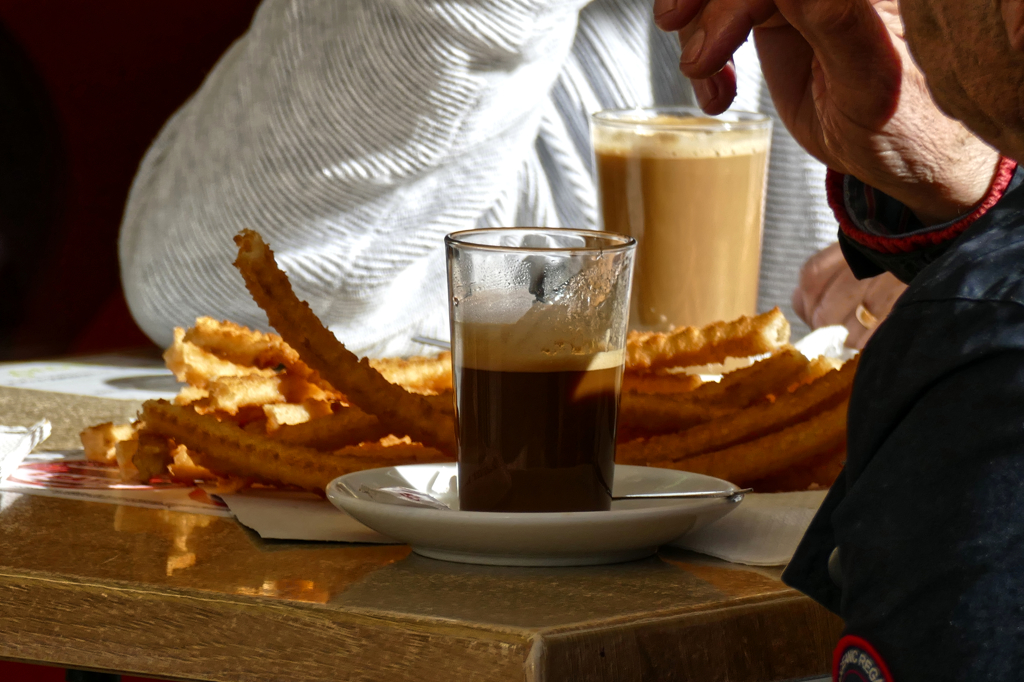
Therefore, if your hotel does not offer any breakfast – or only very limited breakfast options – enjoy your morning coffee rubbing shoulders with locals at one of the many cafés.
While churros, fried dough dipped in liquid chocolate, are definitely very tempting, make sure to try another Spanish breakfast staple, namely a tostada with olive oil and freshly ground tomato. Sounds simple, but is super-yummy.
Markets and Supermarkets
Just like in Italy, some Spanish supermarkets have a food counter where you can buy simple dishes like grilled chicken, meatballs, and fritters as well as sides like potatoes and salads. I’m not claiming that this will be the fanciest meal of your life, but if you just need to grab a filling snack, I find it’s a valid option.

Obviously, you can stock up on baked goods as well as fruits at local farmers’ markets to enjoy them during your hikes or on the beach.

The most authentic place to do some local snacking, as well as your grocery shopping, is the Mercado Central at the Plaza de la Libertad. However, make sure to leave room for a generous portion of churros at the Mesòn Las Brisas across from the market’s southwest corner.
Tapas and Menú del Día
There is an overwhelming number of bars and restaurants in Cádiz where you can enjoy a glass of beer or wine with some tapas, varied small snacks. Tapas can be slices of serrano ham, diced cheese, olives, small sandwiches, a blob of ensalada rusa, potatoes salad with mayonnaise – you name it.
Apart from the tapas, which are the smallest portions, you can also order most foods as a ración, hence, a full serving, or also media ración, a half-sized serving.

If you are really hungry, the menú del día might do. It’s usually a three-course meal that you can combine to your liking from different starters, main courses, and dessert options. Often, they include water, a soft drink, or even wine or a small beer.
Cash and Cards
Until now, 20 European countries replaced their former local currency with the €uro starting in 2002. Obviously, Spain is one of them. The exchange rate is 1 US$ = 0.84 EUR as of September 2025. However, you can check today’s conversion rate on this page.
You can pay with credit cards basically everywhere – as a matter of fact, due to the pandemic, most businesses prefer contactless paying by credit card for safety and hygienic reasons.
Connection and Communication
Since June 2017, no roaming charges apply within the EU with a European mobile phone contract, This applies in all 27 countries of the European Union, as well as in Iceland, Liechtenstein, and Norway, and to all contracts.
In case European roaming is not available, you can connect to the internet without any issue at basically every museum, eatery, or café, and, of course, hotel.
If you insist on being online 24/7, you can get a SIM card, obviously. The cheapest one would be Lycamobile while Orange Tu Mundo has the widest coverage.
In Spain, they use plug types C and F. Their voltage is 230 V, and the frequency is 50 Hz. Whereas nowadays, all these chargers have integrated adapters, in general, the voltage and frequency don’t really matter. By the way, you’ll find this information and many more comprehensive travel tips in my post World’s Most Complete Travel Information – an indispensable globetrotter classic.
Language
Obviously, the official language is Spanish. If you want to learn some basic Spanish or just brush up on your knowledge, there are various apps and online tools. I personally like to practice with babbel. However, due to international tourism, many people speak at least some rudimentary English.
Nevertheless, here are some ground rules for Spanish pronunciation since saying, for instance, city names incorrectly can cause some problems.
Say It Right
In general, you read Spanish the way it’s written. Although, the letter C is a bit tricky for foreigners. Placed before an A, O, or U, it’s hard and pronounced as K. Followed by E or I, it is pronounced like an English the. That’s in Spain, Latinos don’t do that, they pronounce it like a normal S. Now, if you want that th-sound in combination with A, O, or U, the letter Z comes in the picture.
So you have to pronounce Cádiz Kadis, and Zaragoza Tharagotha or Saragosa.
On the other hand, if you want C to sound hard in combination with E or I, you make it a QU – but again, you don’t hear the U. Fine example: Tequila, that you pronounce like Tekkila.
This applies also to the letter G. If it’s followed by A, O, or U, it’s pronounced like the G in guitar, hence, hard. This is also the perfect example of how to make a G sound hard before an E or an I: They squeeze in a mute U. On the other hand, if it stands before an E or an I, it is rather breathed than pronounced – a bit like the H in house.
The same applies to the letter J. You always pronounce it like the H in house. If you speak for instance German, Flemish, or Czech, you get even closer by pronouncing it like a CH in echt.
Always, no exception, no matter which vowel follows.
A last trap is double L which is not pronounced like an L but like a Y in yellow. So it’s not Malorca, but Mayorca. However, don’t overdo it. When a word is written with just one L like Tequila, it’s a simple and innocent L.
Alone No More
Although I’m an avid solo-travelling woman, I sometimes like to join organized tours. Not only are they a valid option to go to remote places since I’m not driving. They also allow me to meet fellow travellers – for just a short moment or a lifelong friendship.
Therefore, here are some great ideas of what to do when visiting Cádiz. Especially during high season, pre-booking online will guarantee your place at the activity of your choice*:
Map
This map should help you to find all the wonderful places I’m introducing in this post. Clicking on the slider symbol at the top left or the full-screen icon at the top right will display the whole map, including the legend.
Cádiz was only one of many amazing places I visited during my road trip through Andalusia. To read about the others, go to the main post and take your pick! There, you’ll also find further valuable general information that will make your own trip much smoother and more enjoyable.
Pinnable Pictures
If you choose to pin this post for later, please use one of these pictures:
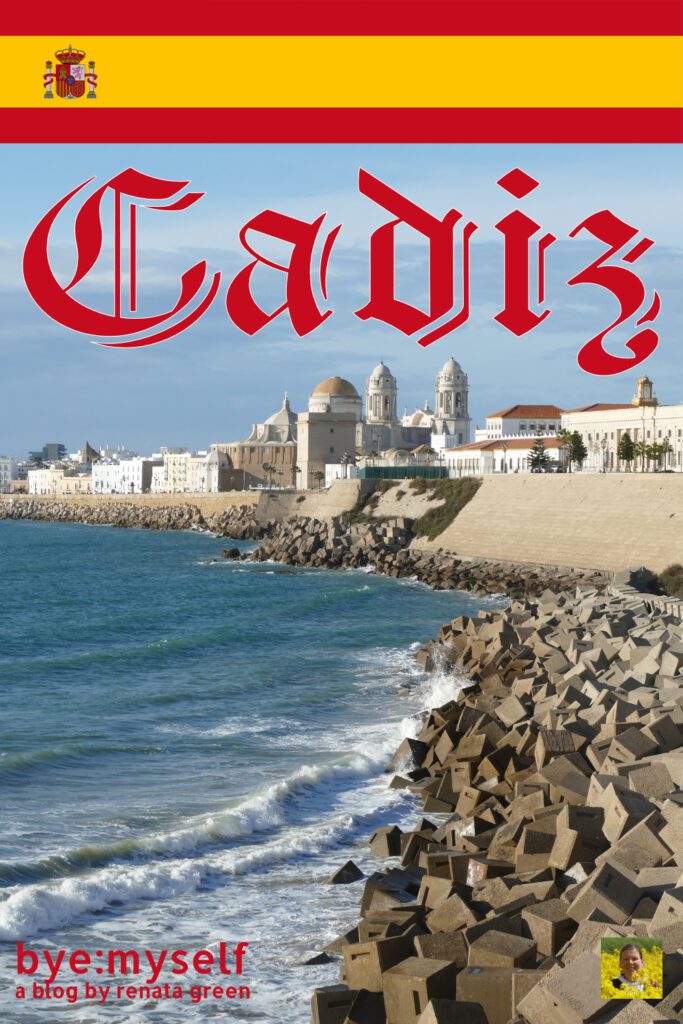
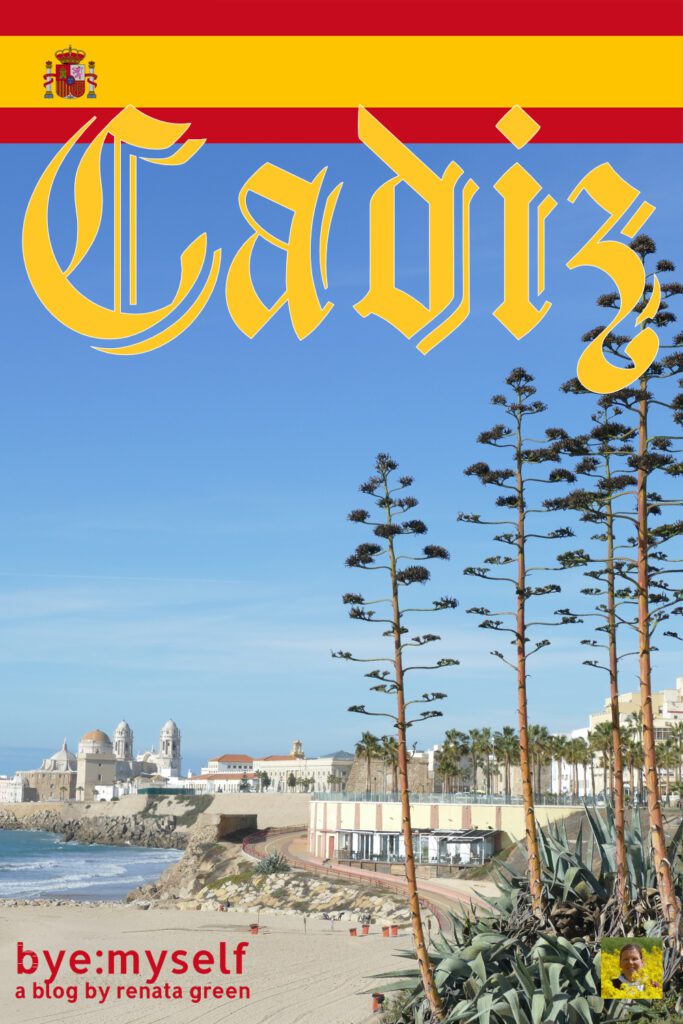
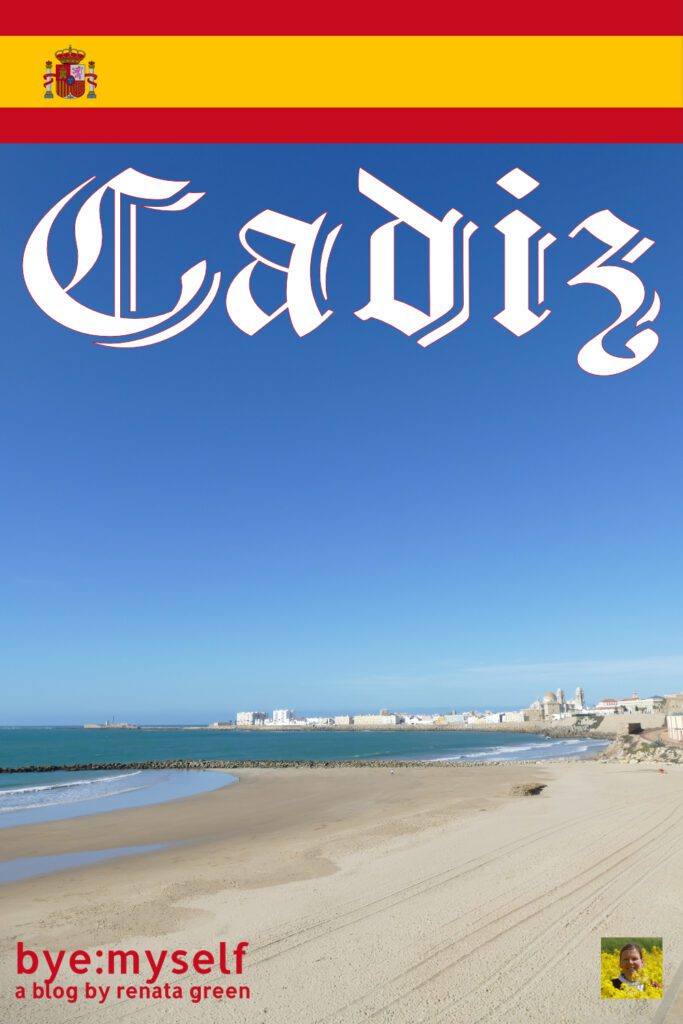
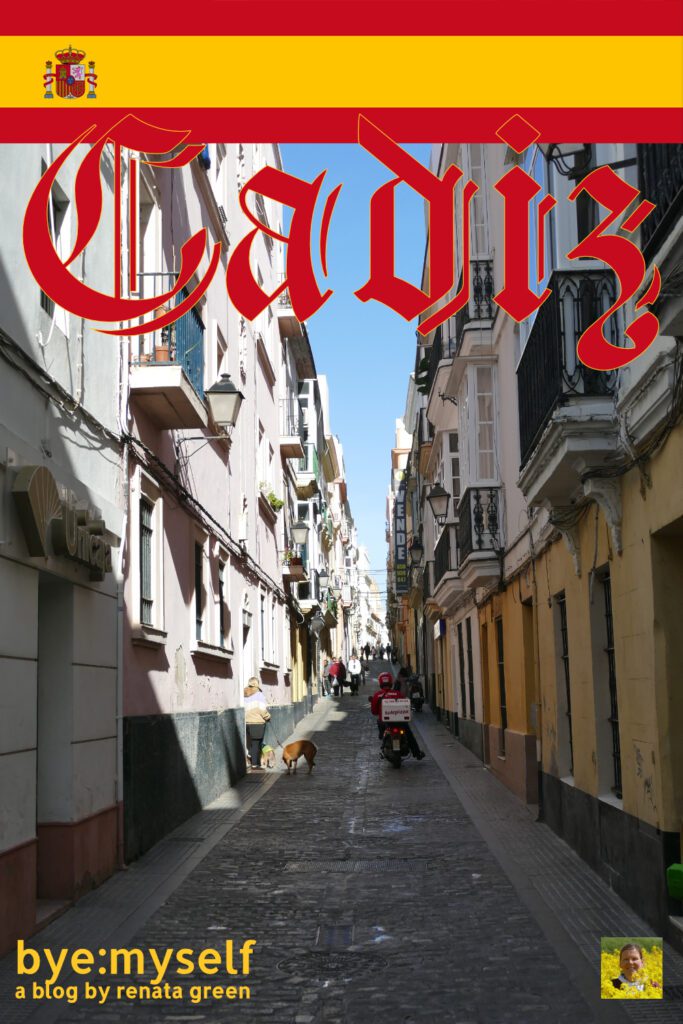


Note: I’m completing, editing, and updating this post regularly – last in September 2025.
Did You Enjoy This Post? Then You Might Also Like These:
Best STREET ART in PALMA de MALLORCA
Weekend in VALENCIA. Ten Reasons Not to Miss Out on a Visit
A Visit to the Colonia Güell – Where Eusebi Güell Created His Universe
Best Things to do in FUERTEVENTURA in One Week
EL MEDANO – where not only the wind will blow you away
Guide to JEREZ de la FRONTERA – Flamenco, Carthusians, And Sherry Wine
Break a Leg – My Bumpy First Encounter With Gran Canaria
GARACHICO – ICOD DE LOS VINOS – MASCA – Touring Tenerife’s Delightful Northcoast
* This is an affiliate link. Hence, If you book through this page, not only do you get the best deal. I also get a small commission that helps me run this blog. Thank you so much for supporting me!
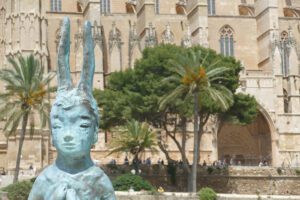


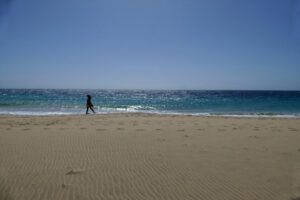




I’ve not been to Cadiz yet, but your article has intrigued me. I wasn’t aware it was the oldest city in Europe. With that claim, it would be interesting to explore the history and culture. Since I’m not a beach person, other than a walk at sunrise or sunset, I would be more interested in visiting the sites and the landmarks.
Cadiz is super-nice: Interesting old town and endless beaches – what else can you ask for?!?
Your guides are always so comprehensive, especially ptactical info including bakeries and delis! This one about Cadiz, even though it missed out on the beaches, truly showed the old-ness, the history, and the culture of the city. I didn’t know you had roots in it.
I love Cadiz. It is one of my favorite cities in Andalucia. I love the old part of the city, Castillo de Santa Catalina, Plaza de la Catedral with the Iglesia de Santiago Apóstol. An excellent guide with lots of useful tips for planning your trip.
Thank you so much – especially since it’s coming from an expert 😉
I never really knew much about cadiz but it sounds full of rich history. However, with all that urban exploring its a shame there wasn’t time or the right weather for the beach. It looked beautiful.
Well, I was there beginning of December, and if you just look at the sky, you’ll see that the weather was better than you can expect at that time of the year 😉
This guide is awesome! I knew very little about Cadiz so I found this very helpful. Thanks for sharing!
It is a really great place – highly recommended! 🙂
This is the first I learned about Cadiz. So much to see and an amazingly long history. Beaches look fantastic and the food is tempting. Lovely place to visit. Thank you for taking us there!
My boyfriend has told me so many wonderful things about Spain, and he has expressed a desire to return to Cádiz. I didn’t pay much attention to it, but reading about it here makes me want to visit this lovely city. I’m a lover of history and beautiful architecture, plus the fact that there’s a beach appealed to me!
Europe is beautiful no doubt. I didn’t know about Cadiz before. It has a rich history and it was reading informative reading your post on it.
Europe and its rich history and culture always facinates me. I was wonderful reading about cadiz.
Cadiz had not been on my travel radar before but that is how we find the “off the beaten path” destinations. I especially love the picture of your rental with the beautiful flowers. Looked like an inviting place to stay.
I must say that the beautiful apartment definitely added to the wonderful experience 🙂
I’ve never heard of Cadiz but it has a rich history and it’s always great to discover new places!
WOW what a special place to visit!! And that coast line is stunning.
Yes, Cadiz is the perfect mix of culture and leisure 😉
This is a such a beautiful city. I am so surprised I have never heard of it before, but I for sure would love to see it in person.
Yes, it’s less known than many other Spanish cities – which makes it kind of a hidden gem 😉
Woah! Thanks for sharing all your stories! So much history in one place and it looks so beautiful!
…and now you know why it’s one of my favorite Spanish cities 😉
Looks filled with beautiful beaches, culture, and activities. I’d love to visit here!
Amazing place! It’s good to know about this and hopefully, I can travel one day to there!
I have to admit I have never been to Cadiz. It looks like a place to visit for me. especially since it’s Spain and I love it
Thank you for sharing this guide! This is very helpful for people who are planning to visit this beautiful city. I am hoping to visit these beautiful places someday!
I wasn’t familiar with Cadiz, and it is interesting to learn about this city. It sounds like there are so many great things to see there. It is nice to visit a place that has a lot to offer like this and to be able to explore.
We have not yet visited Cadiz so it was good to get a walkthru in your post! It would certainly be interesting to explore the culture and history. But I must admit we would be drawn to the long stretches of beautiful beaches. I could find a beachside bar and just watch the water for hours. We certainly would plan a long enough visit to take in all there is to see and do. Definitely a stop for a return visit.